« March 2005 | Main | May 2005 »
April 29, 2005
Computer Game Development Showcase

Game design and development at NCSU
"The Computer Game Development Showcase, the semester-ending presentation of student projects in the combined courses covering computer game development taught by the Computer Science Department and the Department of Industrial Design, has been scheduled for Wednesday, May 4, 2005 from 8:30 pm to 10:30 pm at Kamphoefner Auditorium on North Carolina State University's main campus in Raleigh." Showcase schedule of presentations.
"Projects to be shown during the showcase are the result of semester-long collaborative efforts between teams formed from students in Computer Science's course on Computer Game Design and Development and Industrial Design's 3D Realtime Modeling and Animation Studio. Each team will present a completed 3D game with custom artwork, 3D models, game play, character AI and interface design developed by the team members.
The event will begin at 8:30PM with a series of presentations by the project teams introducing their games. Following the presentations, all games will be accessible at PCs set up in the auditorium, providing attendees the opportunity to play the games and talk with the developers to learn more about the art and science that went into their construction. The event is free and open to the public."
Posted by at 07:31 PM | Comments (0)
The Telepathic Table
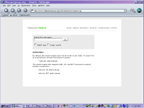
Step 1: Select a Table
16 Beaver Group was invited to be part of Version<05 in Chicago. We will be given a table at the Zhou B. Center (Chicago) between 12:00pm and 8:00pm on Saturday April 30th and May 1st.
While we've tried to deal with placing representative objects on display, whether it is a wall, a table, or a pedestal, it is very difficult, if not impossible, to 'represent' what we do. Instead, we insist on ‘activating’ the social environment to which we’ve been invited. So having been offered this table has now triggered the following kinds of questions: How are tables social and political objects? How can this social aspect be enacted, rather than represented? What can we all do with a table, to fully take advantage of its potential? Are tables used for the same things in different cities around the world? What is the significance of tables in the date of May 1st?
We are also aware that events like Version<05, as well as the World Social Forum, or more specifically art oriented endeavors, such as the growing number of international Biennials, are based on the assumption that people need to be physically present in one place at the same time. This creates a big conflict with the reality of art budgets, which are hardly sufficient to provide for a basic living. Needless to say, the idea of travelling around the world on this budget seems impossible, especially for alternative initiatives and artist run spaces. So, very much like we’ve done in the past with projects like ‘The International Lunchtime Summit (2003, in 21 cities around the world), we are now telling everyone who is interested in art, politics, and social change, that they don’t have to move from where they are. You can join the Telepathic Table, and be with us all, in different places, at the same time.
1. How it works and how you can join, wherever you are.
- Select a table in your town or city, invite some people to do something with it at any time this coming Sunday, May 1st. What you do, and what you call it may or may not have anything to do with the questions or ideas listed above. What you do on May 1st can be the first gesture toward a table project you can develop for two weeks after that. We will collect materials related to all table projects between May 2nd and May 15th, and then put them all up, organized by city at: http://www.16beavergroup.org/chicago
The webpage will be up on the night of May 15th.
These are the kinds of materials we’d love to put up related to your project:
- Take a photograph of the table when your gathering begins, and one when it ends (Note that your table may be a cloth, if it’s a picnic, or many other things)
- Any texts, images, or ideas that can be emailed, produced on May 1st or afterwards (May 2nd to May 15th ) related to your table or the ideas above.
- A list of participants, title of project if there is one, and any urls that might be good to put up for more information on participants.
Email all materials gradually or in one big bunch to: peterlasch(at)16beavergroup.org
You don’t need to contact us before May 1st. Just do something with other people at a table, think telepathically, politcally, artistically, and send us the results after it happens! We’ll put it all up.
2. Local contacts and information for your city (so far Arhus, Baltimore, Chicago, New York, more coming)
Go ahead and add your own group/table/project and let us know what happened after you do it. You can also join one of the following if you’re in NY, Arhus, Chicago or Baltimore. See the details or email the contact person for info.
Aarhus, Denmark – at - rum46
Contact: rum46(at)rum46.dk
Baltimore, USA - at The Contemporary Museum- Patriot
Contact: Jesal Kapadia: jesalkapadia(at)hotmail.com
Chicago, USA (Sunday, May 1st – 1:00pm – 4:00pm)
- 16Beaver, Red76, Mess Hall, Polvo, Temporary Services, Chiapas Media Project, subRosa, others (not all participants are confirmed)
Contact: Peter Lasch: peterlasch(at)16beavergroup.org
We will gather at 1:00pm at the 16Beaver Table at the NFO Expo, work on tables and then literally carry our table into the Chat Room for a discussion on Alternative Spaces in the same building (Zhou B. Center) at 2:30pm. Everyone is invited, and no need to stay the whole time. You can drop in and out as you wish.
New York, USA (May 1st -- Washington Square Park, 2:00pm-4:00pm)
16Beaver, Reverend Billy, many more
Contact: Ayreen Anastas: everytime(at)16beavergroup.org
We’re joining the Rally at Washington Square Park, against the redesign / privatization / fencification of the park. We’ll meet under the Arch at 2:00pm.
See the info online at: http://www.openwsp.com/user/may1alert.htm
Please sign the online petition if you like.
A table in the park is a table cloth mostly and it can be used as a rally
banner as well as a picnic cloth. We’ll do both at different times. Bring
your banner. Bring your table.
Eat and scream.
Posted by jo at 10:35 AM | Comments (0)
Demotic

Pertaining to the Everyday
Demotic--by Antoinette LaFarge + Robert Allen--is a performance work about American Memory, a single character whose many voices are woven together into a complex texture of language, sound, and music. It is an improvisation among different kinds of performers and different modes of reality, involving sound artists, a theater actor, and a group of Internet-based performers who improvise with text. As an ensemble work in which actors, avatars, and musicians find the music within a wide range of online voices, it is a kind of covert national anthem.
Demotic premiered at the Beall Center for Art and Technology, Irvine, CA, on July 29, 30, and 31, 2004. It was broadcast by KUCI 88.9 FM in Irvine on July 31, 2004, and all three performances were webcast live by UCI and Location One gallery, New York via RealMedia streaming audio.
Posted by jo at 07:45 AM | Comments (0)
Psymbiote
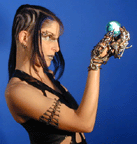
Hybrid Apparatus for Social Interface
Psymbiote is a cyborg performance persona by isa gordon in collaboration with Jesse Jarrell & DEvan Brown. Adorned in titanium, latex, silicone, and electronic apparatus, isa/Psymbiote places herself in the eye of the storm: the conceptual terrain at the collision of bodies and machines, the mutation of her own identity through transformation of the body. Ultimately the project seeks to fully transform the artist into a seductively organic yet entirely unfamiliar hybrid organism, a human/machine chimera with fully integrated control systems. The costume is being animated with movement, sound, and light; activated by manual triggers, automatic body processes, and remote control. As her evolution progresses, Psymbiote appears in public spaces to stimulate dialogue regarding the future of technological enhancements to the human body.
She has already been sighted at a number of universities, art shows, international conferences, and as host of the SIGGRAPH CyberFashion Show. The Psymbiote Project brings issues raised by the ongoing redefinition of our bodies into a public forum, highlighting some of the contemporary critical discourse surrounding cyborgs and all forms of human/technology integration.
Posted by jo at 07:43 AM | Comments (0)
April 28, 2005
The Passion of Henry
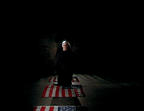
"Power is the Ultimate Aphrodisiac" - Henry Kissinger
Jerry Snell proudly presents his new collective creation: The Passion of Henry, an industrial performance event denouncing over 40 years of international terror. The result of a research and creation residency at SAT, The Passion of Henry will be presented April 28 & 30 at 8pm. Artist, director and composer for dance, theatre, cinema and circus, Jerry Snell’s new collective creation fuses all these elements, collaborating not only with artists from Canada but also from China, Vietnam, Japan, Netherlands, Belgium and Chile. The Passion of Henry excavates the mind of Henry Kissinger, mythical icon of international hypocrisy of the American political society.
Integrating 5 video screens and mixed with archive materials, live music and performed on stage by actor Pascal Dabe from Belgium, The Passion of Henry presents a sarcastic and cruel reflection of our contemporary world. Henry Kissinger: Nobel Peace Prize recipient, mass murderer, anti-Christ or playboy?
Participants include: Pascal Dabe (actor), Michel F. Côté (composer), Lorne Brass, Thien Vu Dang, Martin Laporte, Yasuko Tadokoro (film and video), Pascale Montpetit, Kurt Chen, Goos Meeuwsen and Alacanté de Chilé (virtual performance),
Posted by jo at 07:47 PM | Comments (0)
Tout-Fait

Marcel Duchamp
Tout-Fait: The Marcel Duchamp Studies Online Journal, is the first academic journal in electronic format devoted to Marcel Duchamp (1887-1968) and his peers. The term "tout fait," the standard French translation for "ready-made", was a phrase used by the French mathematician Henri Poincaré (1854-1912), whose influence on Duchamp was crucial. Thus, Tout-Fait not only represents the intersection between art and science, but serves as a site promoting the interdisciplinary study across diverse fields of scholarship.
Tout-Fait brings together international scholars and writers from art and science backgrounds and many other fields of study. An interdisciplinary project, Tout-Fait is committed to presenting a variety of news features, articles, interviews, and short notes relating to Duchamp, one of modern art's most important figures, and his circle of contemporaries. [via loreto martin]
Posted by jo at 08:04 AM | Comments (0)
Radio_Copernicus
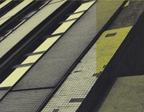
Call for Radio Art-Proposals
Radio_Copernicus is an independent and transnational experiment. Its topic is the artistic use of radio's electroacoustic spaces and materials as well as its diverse communication architectures and its metaphorical potential. Radio_C is dedicated to the multitude of aesthetic concepts and strategies of the digital age and will, at the same time, value the history of radio art and sonic media art in general. This will make Radio_C an art event in itself.
Radio_C will be on air from mid-July to the end of December 2005. The progam cooperates with media art and music festivals in Poland and Germany, such as "garage"/Stralsund, "Warsaw Autumn" and "Dis_Positionen"/Academy of Arts, Berlin. In early December 2005 the project will organize an international symposium dealing with the topic of independent artists' radio in Wroclaw/Poland.
Radio_C will be on air temporarily during the time of the festivals. Also, it will be constantly available as an Internet livestream for the international community. It will broadcast in Polish, German and English, and will cover a broad range of artistic categories, with spoken word based art forms and presentations being as important as experimental music, hoerspiel and sonic media art.
The project considers itself part of the recent movement of independent art und cultural radios, such as Resonance.fm, Reboot.fm, Soundscape.fm and many others. It relates to an idea of the Hamburg based sound artist Felix Kubin. Radio_C‘s aim is to strengthen the artists‘ access to radio, and seeks to join the political claim for independent artists‘ radio’s access to frequency and broadcast.
Productions and projects, which deal with radio's communication architecture, telematic media or want to connect radio with activities in public space are especially welcome.
Also submitted can be radio art pieces, earplays, sound art etc., which are already produced, up to a maximum length of 85 min.
Please, submit proposals for the first two transmission sets (July-September) until May 16 to:
Studio Radio_Copernicus
Universität der Künste
Lietzenburger Str. 45
D-10789 Berlin
Germany
Contact: Sabine Breitsameter info[at]radio-copernicus.org
Posted by jo at 07:56 AM | Comments (0)
Theatre/Archaeology
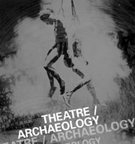
Places Which Perhaps Only the Poet Can Map
"We begin to walk. We feel the ground beneath our feet, the wind in our face. And as we do, we leave traces. We are involved in the landscape. We leave the prints of our body, the touch of flesh on metal and stone. We constantly wear things out, with our hands, our feet, our backs, our lips. And we leave the traces of singular actions: the unintentional, the random, the intimate, unplanned touch of history's passing: we break twigs, move pebbles, crush ants... all the signs that trackers learn to read... And we discard things - we throw things away, we lose things - material which, in years to come, others will regard as artefacts, as the remains of past actions...
We begin to create a palimpsest - writing over writing over writing - in a kind of stratigraphy of text. Perhaps we became frustrated and threw it away, a love letter that wouldn't compose itself. But as we retrieve it, we realise something unusual. Points which were once separated in time and space are now adjacent, in a new non-linear relationship... We try to straighten it out. But of course we can't. It has developed a kind of topography of creases, bumps, rips, all of which will now influence how we might move across it... Different paths enact different stories of action...
It is the matrix of particular folds and creases, the vernacular detail, which attached us to a place... In these notions, landscape is not separate from the lives lived there. But they are not... precise territorial zones, rigorously defined, delineated and patrolled... This is slippery ground, places without firm boundaries, places which perhaps only the poet can map."-- Mike Pearson and Michael Shanks' Theatre/Archaeology
See also: Walking as Knowing as Making; Deep Mapping; Archaeologically speaking... [blogged by Anne Galloway on Space and Culture]
Posted by jo at 07:24 AM | Comments (0)
UpStage
![]()
Next Two Sessions
The next open session in UpStage will happen on Wednesday 4 May, and we're doing two sessions again, so pick the time that works best for you:
First Session: 5am New York; 9am UK; 11am Western Europe; 12 noon Finland; 9pm NZ. Second Session: 4pm New York; 8pm UK; 10pm Western Europe; 11pm Finland; 8am Thursday 5th NZ.
Check http://www.worldtimeserver.com for your local time. If you want to join us as an audience member, come directly to: http://upstage.org.nz:8081/stages/presentation.
If you want to log in and play, email me first for a username and password, then go to: http://upstage.org.nz:8081 and log in.
Posted by jo at 07:16 AM | Comments (0)
April 27, 2005
Art-Domains
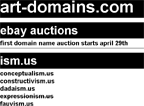
Connecting The Public Domain to the Artworld
Art-Domains, by Peter Luining, is a project that brings internet domain trade to an art context, thus penetrating the space of the white cube with one of the most lucrative virtual money making businesses, that of selling domainnames. For this particular project Peter Luining did over one year of research and became a domain broker himself. He bought and sold domain names to get the knowledge of how this trade works and also to get the best art related names available. Over the last year Luining aquired domain names like clementgreenberg.com, artcriticism.org, marcelduchamp.info, whitecube.us, etc. The Art-Domains stand Luining will present at Art Frankfurt will connect virtual to real space and the public domain of trade to the artworld. At the moment Luining owns about 200 art related domain names that will be offered for the first time for sale at Art Frankfurt. Starting April 29th, art names will be offered for auction at eBay.
For his presentation of Art-Domains Luining uses Mel Bochner's "Working Drawings And Other Visible Things On Paper Not Necessarily Meant To Be Viewed As Art." (1966) as a basis. Bochner's presentation used photocopies and contained ephemeri of "non- art" sources, which were put in identical ring binders and displayed on standard white plinths. Whereas Bochner used new materials to display the creative process over it's results, Luining uses Bochner's classical presentation method (use of standard office techniques i.e. laser prints of webpages) to connect virtual selling strategies with the institutional artworld in a low tech manner.
Posted by jo at 03:03 PM | Comments (0)
Floating Points 2: Networked Art in Public Spaces

Tune in TONIGHT!
Anne Galloway will moderate a panel discussion with participants Julian Bleecker, Elizabeth Goodman, Greyworld, and Teri Rueb. After each artist has presented their work, she will engage them by asking the following question:
"Isabelle Stengers has described the creative enterprise as an “adventure of hope” - inherently political processes in which we resist the probable and fully engage the possible. And Chantal Mouffe has pointed to other “social imaginaries” crucial in revitalising an everyday politics of hope. What kind of hope do you see in networked public space? How do you see hope acting in your work? What possibilities and imaginaries drive you?"
DATE & TIME: April 27, 2005; 6:30 p.m. (EST, US); VENUE: Emerson College, Bill Bordy Theater, 216 Tremont Street, Boston and streamed live.
Posted by jo at 11:42 AM | Comments (0)
The Hug Shirt

Soft Technological Sandwiches
F+R Hugs is a soft Lycra shirt with embedded sensors and electronics that allows to feel the physical closeness of a distant loved one, bringing the sensation of a hug. The system works through a mobile phone network. The shirts receive the input of heart beat, touch and body temperature of the remote loved one, recreating (through actuators embedded in the shirt) over distance the pulsation, physical pressure, and warmth of a real hug.
During the testing of the shirts, major intensity points were identified on upper arms, on the upper back part during a condolatory hug, around the waistline, neck, shoulders, and hips. In these strategic spots were placed soft technological sandwiches containing the hugging output actuators. Designed by Francesca Rosella - Ryan Genz, Cutecircuit; other works by Cutecircuits: Kinetic and cameleon garments. [blogged by Regine on near near future]
Posted by jo at 08:09 AM | Comments (1)
Presence
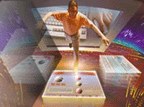
AR/VR:Mind/Body
"ABSTRACT: In augmented reality (AR) environments, users experience the physical environment and other users directly along with the mediated virtual objects embedded in the environment. In immersive virtual reality (VR), the user's experience of a visual environment (and sometimes other senses) is completely mediated. The representation of the user's body in virtual environments granted us new research territory in dualistic interaction between the mind and body: how do the virtual body and the user's mind interact (with) one another and eventually effect the user's behaviors in the envrionment? An experiment was conducted to explore the potential effect of users' and interactant's bodies to sense of presence in VR and AR environments. Results from the study suggest that the absence of representation of the user's body in VR environments may lessen (her) sense of spatial presence compared with AR environments." From Comparing Differences in Presence during Social Interaction in Augmented Reality versus Virtual Reality Environments: An Exploratory Study by Tang, A., Biocca, F., and Lim, L. (2004).
Posted by jo at 07:48 AM | Comments (0)
eRuv
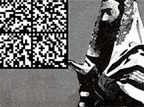
A Street History in Semacode
eRuv: A Street History in Semacode, by Elliott Malkin, is a digital graffiti project installed along the route of the former 3rd Avenue elevated train line throughout Lower Manhattan. This train line was part of a religious boundary called an eruv for the immigrant Polish Chasidic Jewish community in the first half of the 20th century.
The train has since been dismantled and most of the Chasidic Jews have moved away, so what was once both a physical and symbolic enclosure is now purely imaginary, a psychic boundary that intersects present-day communities in Lower Manhattan, most notably in Chinatown.
Each location along the eruv corresponds to a semacode ID. New Yorkers or tourists using a compatible camera phone can receive audio content (in Chinese, Spanish, Yiddish, and English) associated with that location, true stories from the past associated with that point in space. Participants will also have the option to leave their own "oral history," a voice message about their experience with that same space or a reaction to the historical reconstruction.
It is important for eRuv to be provided in the above four languages, as the purpose of this project is to undermine the sorts of boundaries that separate cultures in New York across time and space. eRuv uses boundaries and awareness of boundaries as a way of undermining those very cultural boundaries.
The work will be part of the Provflux, an event dedicated to artistic and social investigations in psychogeography. May 27-29, in Providence. [blogged by Regine on near near future]
Posted by jo at 07:02 AM | Comments (0)
April 26, 2005
Video Conferencing Software as a Performance Medium

Is There No There There?
"ABSTRACT: This paper surveys past performances in which the author collaborated with several other dancers, musicians, and media artists to present synchronized co-located performances at two or more sites. This work grew out of the author's participation in the landmark computer music ensemble, "the HUB". Each of the various performances were made possible by an evolving array of video conferencing hardware and software. These will be discussed. The problems and interesting side effects presented by latency and dropouts are a unique part of this performance practice. Leveraging the concepts of shared space, video and audio feedback generate evolving forms created by the combinations of the space, sounds and movements of the participants. The ubiquity of broadband Internet connections and the integration and constant improvement of video conferencing software in modern operating systems, makes this unique mode of performance and essential area of research and development in new media performance." From Video Conferencing Software as a Performance Medium by Scot Gresham-Lancaster.
Posted by jo at 10:31 AM | Comments (0)
The HUB

One Instrument, Many Parts
The HUB, a group of composer/performers, were among the first to practice network music. The Hub is a computer network band. Six individual composer/performers connect separate computer-controlled music synthesizers into a network. Individual composers design pieces for the network, in most cases just specifying the nature of the data which is to be exchanged between players in the piece, but leaving implementation details to the individual players, and leaving the actual sequence of music to the emergent behavior of the network.
Each player writes a computer program which make musical decisions in keeping with the character of the piece, in response to messages from the other computers in the network and control actions of the player himself. The result is a kind of enhanced improvisation, wherein players and computers share the responsibility for the music's evolution, with no one able to determine the exact outcome, but everyone having influence in setting the direction.
The Javanese think of their gamelan orchestras as being one musical instrument with many parts; this is probably also a good way to think of The Hub ensemble, with all its many computers and synthesizers interconnected to form one complex musical instrument. In essence, each piece is a reconfiguration of this network into a new instrument. (Perkis)
The Hub, formed in 1984 in and around San Francisco, by Tim Perkis, John Bischoff, Scot Gresham-Lancaster, Phil Stone, Chris Brown, and Mark Trayle, used a network approach to improvisation, where each player controlled an aspect of the same compostion.
Posted by jo at 09:30 AM | Comments (0)
Taken
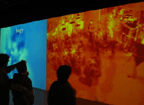
Tracing Memory
"A small enclosed gallery off of (Williams College Museum of Art's) historic rotunda, Media Field is the museum’s sacred space for video and new media work. The Toronto based artist, David Rokeby has inhabited it with his video installation Taken, specifically reformatted for the space. The work establishes a surveillance environment that monitors the room with a three-channel video projection, tracing the memory of the gallery, so to speak. Rokeby’s software responds to every visitor by focusing and recording their movements in a looped video format on three walls, leaving the center of the gallery light up and empty in wait for a performance.
That performance is your blurred image within a stream of transparent bodies flowing through the room [the day’s palimpsest of visitors] featured in the main projection. Once a new presence is detected the crowd vanishes and the new visitor is isolated in the space. Walking into the room gets you noticed – quickly- and just as quickly, you are stitched into the quilt of the gallery’s daily memory." From David Rokeby @ WCMA by Dina Deitsch, Big Red & Shiny #21.
Posted by jo at 09:28 AM | Comments (0)
Provflux 2005
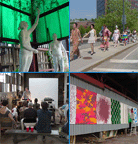
Implementation to be Featured
"Nick and I recently got word that Implementation has been accepted by Provflux 2005, both as an Intervention (live event) as an exhibition. Implementation’s second gallery exhibition will take the form of mounted photos from the project, a DVD of distance shots, and take-home sticker sheets on display at CUBE2 Gallery in downtown Providence, Rhode Island from May 19th until the end of the month, and we’ll be in Providence May 27th-29th for the event itself, with a goal of distributing, placing, and documenting the entire novel in one weekend in one location. Bring your digital camera and camping gear if you want to join us. Implementation joins about 50 other public interventions, games, urban exploration, lost space recovery, and tech mapping projects for this fluxist/situationist/public art happening." [blogged by Scott on grandtextauto]
Posted by jo at 09:10 AM | Comments (0)
April 25, 2005
Itinerant

A Site-Specific Sound Installation in Boston Common
Itinerant--by Teri Rueb--is a site-specific sound installation in Boston, Massachusetts. It invites people to take a walk through Boston Common and surrounding neighborhoods to experience an interactive sound work that re-frames Mary Shelley's Frankenstein, the classic tale of conflict between techno-scientific hubris and the human spirit. The project engages a search for an elusive character who is doppleganger to both the doctor and the creature. Sounds, 'played' by visitors as they move through the city, create a series of frames within which to reflect upon our highly mobile, technologically saturated society and issues of identity, place, and displacement. Mobile and locational media (GPS) formally underscore themes in the work. The sonic overlay is also presented as an interactive map on the web, creating a formal re-framing and displacement of this site-specific work (needs Flash Player, headphones and broadband connection).
Equipment may be picked up through May 7, 2005 at the Judi Rotenberg Gallery, 130 Newbury Street, Boston. "Itinerant" is a 2005 commission of New Radio and Performing Arts, Inc. (aka Ether-Ore). It was made possible with funding from the Jerome Foundation and the LEF Foundation.
Posted by jo at 01:34 PM | Comments (0)
Walk Los Angeles With Me
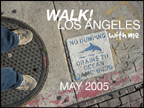
In Search of Poetry
"Hello Friend,
On Sunday 15th May, at noon, I'm setting out of my house in Echo Park, Los Angeles, and not returning until I've walked the whole of L.A. I'm going to trek the city of Los Angeles like an explorer charting uncharted territory. And I'm going to be stopping people on the streets and inviting them to walk with me too - and videoing what happens when they do from a video camera attached to a baby stroller I'll be pushing around with me. The footage from that, along with photos and writing, will be regularly updated into a video blog while I'm on the road and later compiled into a film of what LA revealed itself to me as when I stepped out of the bubble of my car, my tv and my preconceptions.
Basically, I'm looking for poetry where it's often easiest to miss it. Please check out my website!" [via city of sound]
Posted by jo at 12:31 PM | Comments (0)
Location33
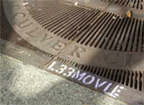
Envisioning Post iPodalyptic Mobile Music
Location33 investigates the potential for new types of music made possible by location tracking and wireless technologies. Listeners, with a GPS enabled PDA or mobile phone, walk around downtown Culver City, California and create a musical album that merges the traditional model of the song cycle with interactive narrative, location awareness, and game play.
Twenty nodes throughout the Culver City area act as portals into the world of the album. Each node is linked with a fragment of a song and when a player approaches one of the portals the music file is streamed to their device.
Each day a specific song is active. It is composed of fragments representing a verse, a chorus, or a bridge. As players walk around, they piece together the fragments, and develop the sense of their path being a song. Each day yields a different song, and all of the components for each day are composed within the limits of a singular musical idea or theme. The album is generated over the course of the week.
The album also focuses on a particular story element, which is sung by one of the characters, Mack, Mackbot, or the Narrator. It is up to the player to discover these musical story fragments and piece them together to form a cohesive story. In particular, the Narrator’s purpose is to contextualize the album within the setting of Culver City and to help the player with hints and instructions.
Location33 also adds elements of game play, asking the player to move around the space to find story fragments in a type of musical and narrative scavenger hunt.
Besides, players can alter the temporal structure of the album, performing time travel operations to experience the album without having to be in Culver City on each day of the week.
Location33 is the thesis project of William Carter, student in Interactive Media at the USC School of cinema and TV.
Read the PDF and doc presentations to see how it works. [blogged by Regine on near near future]
Posted by jo at 12:17 PM | Comments (0)
Walking as Knowing as Making
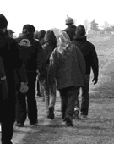
One Foot in Front of the Other
"With all the attention that 'locative media' seems to be getting within new media communities, it only makes sense that the actual process of moving bodies through space and place should be seen as a site worth investigating. The history of artists exploring the performative nature of walking--from Richard Long to Yayoi Kusama--provides one starting point for many contemporary practitioners. To give this developing history some context, the College of Fine and Applied Arts at the University of Illinois at Urbana-Champaign is hosting a symposium called Walking as Knowing as Making: a Peripatetic Investigation of Place.
About to start it's fourth, and final, session, the symposium has already delved into the social, environmental and aesthetic dimensions of walking with talks and guided walks by such notables as long time 'walking artist' Hamish Fulton. The upcoming fourth installment, beginning on 28 April, includes presentations by artist Walid Raad (of the Atlas Group) and architectural theorist Jane Rendell among others. If you're too far to walk to the events, you can find discussions and documentation from the symposium online. - Ryan Griffis, Net Art News, Rhizome.org
Posted by jo at 10:53 AM | Comments (0)
lifeClipper

The Walking Experience
lifeClipper is an open air art project. It offers an audiovisual walking experience in a virtually enhanced reality. Technically it is based on portable computer equipment worn by an individual. When walking around in a chosen culturally interesting area or impressive landscape the visitor's position and viewing direction is measured by means of GPS and the found situation augmented according to defined presets. Image and sound are displayed on an HMD (Head Mounted Display). Live captured image and sound are treated in real time by altering parameters as well as by adding music (composition, spoken text and sampling of documetary material), photo and video material (documentary and fictively arranged).
Through interventions on habitual ways of listening and seeing, reality becomes questioned and day-to-day situations become an adventure. Users feel as though they are watching a film in which they participate as active observers and in which they get attention from virtual players. The borders between subjective and objective perception become blurred as the user is immersed into space and action but also contemplates artistic compositions and cultural reflections. Read a review.
Posted by jo at 09:28 AM | Comments (0)
Geometries of Power
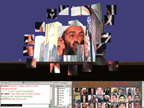
Online Multi-User Event between Boston and Munich
Tamiko Thiel is developing a theory of dramatic structure for virtual reality that merges concepts of structured experience from music theory, drama and urban planning together with the possibilities for user engagement and immersion provided by first-person interactivity. On May 1, 2005, Thiel will present her project Geometries of Power, a multi-user online 3D world that uses the interactive characteristics of space, geometry and sound to question concepts of power and control. Shared event VRML technology enables participants to collaboratively create a 3D visual environment in real time.
You may visit either of the two sites, the Goethe-Institut Boston/USA, or programangels/Lothringer13, Munich/Germany, or you can enjoy the experience in the privacy of your own Internet connection!
To participate on your own you need a WindowsXP PC (sorry, MACs don't work), a good Internet connection and to install the blaxxun VRML-Browser. For more information: Information: +1 617 262 6050 or beeke.tower[at]boston.goethe.org
Geometries of Power was developed during a workshop at the Bauhaus-University in Weimar, Germany.
Tamiko Thiel is an American visual artist of mixed Japanese and German heritage living in Germany who explores social and cultural uses of virtual reality. She has a B.S. in product design engineering from Stanford University, an M.S. in human-machine interface engineering from MIT and a Diploma in Applied Graphics from the Academy of Fine Arts in Munich. She lectures internationally on the creation of meaning in art and of dramatic experience in time-based and interactive media. Thiel is currently a Research Fellow at the Center for Advanced Visual Studies (CAVS) at the Massachusetts Institute for Technology.
Posted by jo at 07:36 AM | Comments (0)
Loca: Location Oriented Critical Arts
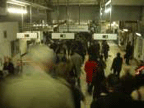
Discoverable
Loca: Location Oriented Critical Arts is an interdisciplinary project on mobile media and grass-roots, pervasive surveillance. A person walking through the city centre hears a beep on their phone, glances at the screen and sees a message: "We are currently experiencing difficulties monitoring your position: please wave you network device in the air." Or "Our server suggests that you may be late. You haven't been charged for this advice."
Loca looks at what happens when everyone can track everyone, when surveillance can be effected by consumer level technology within peer-to-peer networks without being routed through a central point. The idea is to enable anyone with a device that has Bluetooth set to discoverable to be tracked.
As the project develops inferences based on analysis of the data (sever-side) will guide communication with the Bluetooth users. People should be able to participate to the project through their own mobile phone without any additional technology, and without their device needing to be modified in any way.
Pervasive surveillance has the potential to be both sinister and positive, at the same time. The intent is to equip people to deal with the ambiguity and find their own conclusions.
A project by Drew Hemment, John Evans, Theo Humphries, Mika Raento.
[blogged by Regine on near near future]
Posted by jo at 07:25 AM | Comments (0)
ISEA2006/ZeroOne
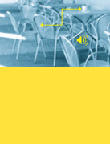
Call for Proposals for The C4F3
Deadline: June 1, 2005: This is an invitation by the ISEA2006 Symposium and ZeroOne San Jose: A Global Festival of Art on the Edge to groups and individuals to submit proposals for an installation of augmented furniture, audio/video/software installations and interactive artwork for The C4F3 (The Cafe) during the ISEA2006/ZeroOne from August 5-13, 2006.
The goal of The C4F3 is to create an active ambient space of augmented everyday objects that is not just an art gallery, a restaurant, or a chill space, but a new kind of project space where the whole environment has been rethought in terms of the capabilities of current technology. This Call for Proposals is an invitation to artists, designers and technologists to propose existing work for exhibition and/or use within the café and new projects that support this goal.
The Inter-Society for Electronic Arts (ISEA) is an international non-profit organization fostering interdisciplinary academic discourse and exchange among culturally diverse organizations and individuals working with art, science and emerging technologies. ZeroOne San Jose is a milestone festival to be held biennially that makes accessible the work of the most innovative contemporary artists in the world. In 2006 it will be held in conjunction with the ISEA2006 Symposium.
Posted by jo at 07:22 AM | Comments (0)
April 22, 2005
Footsteps of Hans Christian Andersen
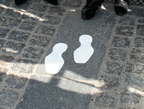
Footstep Hack
"A virtual discovery of Copenhagen in the footsteps of the famous author Hans Christian Andersen has been hacked, possibly by 'gay-activists'. Footsteps of Hans Christian Andersen - A Sound-Walk through the author's Copenhagen is a part of the Danish celebration of the 2005 HC Andersen bicentenary. The project invites people to follow in his footsteps and listen to audio narratives via their mobile phones at selected locations.
The route is marked with 2000 footsteps painted on the sidewalks - however, by adding a few extra footsteps it was diverted to the doorstep of local gay-clubs. The small hack might be a statement, rather than a prank. The HC Andersen anniversary has been criticized by the gay community for ignoring the author's homosexuality. E.g., a papercut by HC Andersen portraying two men holding hands inside a heart was used as a motif in a Christmas decoration by the fashionable department store Magasin du Nord - but instead of two men holding hands, the original artwork was 'corrected' to a woman and a man." See article (Danish) [blogged on guerrilla-innovation]
Posted by jo at 01:17 PM | Comments (0)
Ancient Technologies, Dramaturgy, and Game

Deadline: EXTENDED to April 25
How can traditional performance strategies blend with cutting-edge new media to create artistic forms reflecting today’s dynamic global culture? Join The Kitchen and the Summer Institute’s first invited international Artistic Director, Ong Keng Sen, for a multidisciplinary program exploring the relationships between ancient technologies, dramaturgy and game. Fully accredited by Sarah Lawrence College, this intensive three-week laboratory offers emerging artists the unique opportunity to develop work integrating video, theatre, performance, dance, sound, and text.
Through daily interaction with a select group of professional artists from Asia and the U.S., participants explore ritualistic techniques from ancient cultures within the rich landscape of interactive systems, game design and rules of play. Artist talks and mentoring sessions with industry professionals as well as access to The Kitchen’s extraordinary video archive of performance documentation enrich the curriculum.
Ancient Technologies, Dramaturgy, and Game
July 11 - 29, 2005
Application Deadline: EXTENDED to April 25
Artistic Director: Ong Keng Sen, THEATREWORKS AND
THE FLYING CIRCUS PROJECT, SINGAPORE
Fully accredited by Sarah Lawrence College.
Tuition: $2,800 (includes meal plan and laptop computer)
Partial scholarships available.
For more information please visit our website: www.thekitchen.org
Posted by jo at 01:00 PM | Comments (0)
Sound as Multi-User-Choreography
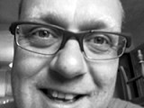
Steve Symons in Conversation with Sabine Breitsameter
"During the last months, the Manchester based artist Steve Symons has been presenting his interactive sound installation Aura in Europe and North America, on big public squares.
Aura is based on the Global Positioning System, which means that it relates sounds to the respective positions and movements of the environment's visitors. Each visitor has to wear a headset and a small rucksack on the back. By this, not only the individual sound-space relationship becomes audible, but also, the visitors are able to distinguish other installation's participants from the passers-by." Continue reading Sound as Multi-User-Choreography
Posted by jo at 09:55 AM | Comments (0)
Subtitled Public
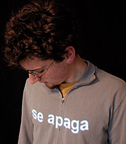
Words Exchange
Subtitled Public, by Rafael Lozano-Hemmer, consists of an empty exhibition space where visitors are tracked with a computerized infrared surveillance system. As people enter the installation, texts are projected onto their bodies: these "subtitles" consist of thousands of verbs conjugated in third person and they follow each individual everywhere they go. The only way to get rid of a subtitle is to touch someone else: the words then are exchanged between them.
Subtitled Public invades the supposed neutrality of the space that museums and galleries set-up for contemplation, underlining the violent and asymmetric character of observation. The piece reveals the danger of surveillance systems that typecast and try to detect different ethnic groups or suspicious individuals, as in the latest computer-vision devices that are being deployed in public spaces around the world. The installation is also an ironic commentary on this era of technological personalization, literally "theming" and "branding" each spectator.
Electronic artist Rafael Lozano-Hemmer (Mexico City, 1967) will be showing his latest interactive installation at "El Cubo" at the Sala de Arte P ublico Siqueiros in Mexico City from April 7th through May 22nd, 2005.
Lozano-Hemmer uses technology explicitly as a way of understanding and criticizing from within some of the paradoxes of our mediated culture, creating intersubjectively binding reference systems. The artist refers to his work as relationship-specific, rather than site-specific, aiming to establish environments where a performative experience can develop, a critical and a connective experience, a kind of communion: communion understood as the acknowledgement of complicity.
For the past fifteen years Lozano-Hemmer has been developing art works that explore the intersection between architecture, interactivity and performance art. His "Relational Architecture" series of large-scale interventions in public space employs custom-made technologies to transform urban environments. Among his most notable works is the transformation of the Zocalo Square in Mexico City with searchlights controlled by participants over the Internet. This piece, Vectorial Elevation, has also been staged in Spain, France and Ireland, drawing massive participation to the project website at www.alzado.net. His works in photography, video and installation are present in important international collections and have been shown at the Istanbul, Havana, Liverpool and Shanghai Biennials among other exhibitions. Currently he is artist in residence at the Institute for Research in Construction of the Canadian National Research Council. Videos, texts and images of his works can be found at www.lozano-hemmer.com.
Posted by jo at 08:59 AM | Comments (0)
April 21, 2005
Participation TV
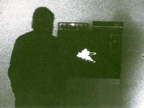
TV as Interactive Canvas
"In 1963, «Participation TV I» (by Nam June Paik) passed the qualifying rounds at the «Exposition of Music—Electronic Television» exhibition in Wuppertal [where, in the case of a few devices, acoustic signals already determined the television image]. [«Participation TV I»] concerns a purely acoustic-oriented type of «Participation TV,» with an integrated microphone. The later version serves a television showing in the middle of its screen a colored bundle of lines which explosively spread out to form bizarre-looking line formations the moment someone speaks into the microphone or produces any other type of sound. Depending on the sound’s inherent quality or volume, the signals are intensified by a sound-frequency amplifier to produce an endless variety of line formations which never seem to repeat themselves or be in any way predictable." (Source: Edith Decker, Paik Video, Cologne, 1988, p. 64) [from Medien Kunst Netz; see related texts]
Posted by jo at 10:52 AM | Comments (0)
Liquid Information
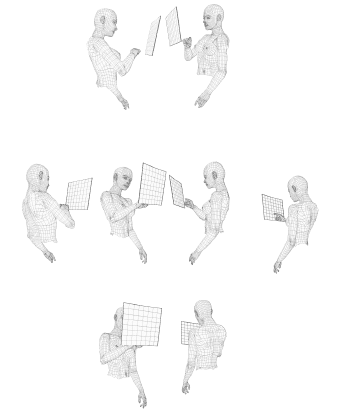
Words >> Hyperwords
Liquid Information is a research project at UCLiC in London in cooperation with Doug Engelbart in California. We are aiming to make text more interactive - turning words into hyperwords. Why? Most electronic communication has focused on the production of information, not the digestion of information. In order to make informed decisions in our work, it's not enough to rely on automated systems - we need to get the right information into our heads.
We believe in giving the professional user a more flexible work environment in which he or she can more flexibly navigate through information, change the way it's portrayed and relate it to other information. Extending the user in this way will help the user digest important and useful information. The web is a great step forward in information access and you can think of this project as an effort to turn web 'browsers' into web 'readers'. This is not about 'links' it's about interactive text - text you can issue commands on, such as 'highlight this word in red' or 'look up the dictionary definition of this word'. [via Clippings.reblog]
Posted by jo at 07:06 AM | Comments (0)
April 20, 2005
9PIN

Mapping the SCAN Community
In summer 2003, a call for artists was sent out for the project 9PIN. The call asked artists to respond to the (then) 9 geographical locations occupied by the consortium members of SCAN. Proposals were submitted for a series of residencies and commissions looking at the possibilities for networking and mapping in the SCAN community. James Coupe, Hedley Roberts and Rob Saunders, Hywel Davies, Armin Medosch and Ivan Pope were chosen because of their range of inventive approaches to the SCAN network.
From Armin Medosch’s data visualisation research starting with a comparison between real and virtual ports through to Hywel Davies’ compilation of a sound database, gathered from each of the consortium venues, for the composition of new material by both himself and other musicians and composers, each of the artists involved in 9PIN makes a significant contribution to their own areas of practice and dissemination of content, whilst helping SCAN to cohere a very disparate group of organisations brought together by their desire to collaborate on high quality experimental work.
Ivan Pope brings his sketches and ideas using GPS, to enhance his interest in psychogeography, to his workshops, while James Coupe and Hedley Roberts take on the difficult task of examining and building an intelligent system which reflects activity (data drawn from sensors installed at SCAN’s member organisations) at each venue in the SCAN network.
The 9PIN project is premised on research and development and brings together artists and makers who are at the forefront of their field. This is a flagship project for SCAN and sets a precedent for the organisation’s aspiration to facilitate an environment for practitioners to develop their process outside of other areas of institutional research whilst working towards high quality outputs for the SCAN network.
SCAN is the innovative new media arts agency in the south of England. As a network of organisations, SCAN is committed to the delivery and facilitation of collaborative works.
"SCAN presents a unique model of networking across a number of diverse arts organisations in the south of England. We commissioned the 9PIN project to explore the network and build a model for SCAN as a whole. We invited artists with an interest in data analysis and mapping to produce a body of high quality work. They have come up with some extremely creative interpretations of the commonalities and differences across the organisations in the network"- Helen Sloan, Director of SCAN
The aim of 9PIN was that each artist should make a significant contribution to their own area of practice, whilst helping SCAN to make connections between the disparate group of organisations that constitute the SCAN network. 9PIN is a flagship project for SCAN and sets a precedent for the organisation’s aspiration to facilitate an environment for practitioners to develop their process outside of other areas of institutional research whilst providing high quality outputs for the SCAN network.
Posted by jo at 09:50 AM | Comments (0)
d>Art.O5
![]()
Distributed Art
d>Art.O5 is the eighth edition of dLux media arts acclaimed annual showcase of recent Australian and International single channel, short experimental digital film and video, web and sound art. Under the sub-title "Distributed Art" d>Art.O5 will both focus on art forms that have an inherently distributed nature (web art, mobile phone art) and investigate new methods for distribution of digital art. (podcasting, BitTorrent, Bluetooth etc.).
d>Art.O5 will consist of an exhibition of sound, web, and mobile phone art and a screening program of experimental film and video art. The exhibition will take place at the Sydney Opera House Exhibition Hall in August/September 2005. The screening program will be presented during this same period.
dLux media arts is now calling for works for the following categories of d>Art.O5:
- d>Art.O5 Screen: Open to Australian citizens or permanent residents only
- d>Art.O5 Sound: Open to Australian and International artists
- d>Art.O5 Web: Open to Australian and International artists
During the exhibition the sound and mobile phone art will be available for distribution to the private devices (mp3 players, mobile phones) of the visitors. After the exhibition period, the sound and screen works will be distributed online through podcasting and BitTorrent, respectively. The web works will be presented in an online gallery on the dLux media arts website. All distribution will be under a Creative Commons Attribution-NonCommercial-NoDerivs License.
The call for entries closes on June 15th. Any entries not completed by this date will not be accepted. Entrants will be notified of the selection results by July 1st.
For more information and to make a submission to d>Art.O5, please visit http://www.dlux.org.au/dart05
Posted by jo at 09:38 AM | Comments (0)
Transmission
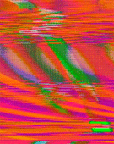
You Can Feel It in the Air
"At some point in our lives, we notice ourselves lugging around an overload of ideas and information. How is it that we continually play the role of unwitting receiver to a barrage of loaded transmissions? Transmission is a series of exhibitions presented by the New Museum of Contemporary Art, which profiles artists and scholars exploring the concept of 'transmission' in and through new media, radio, sound and broadcast media. 'Airborne,' the second show in the series, takes on the 'aesthetic, sonic and socio-political' aspects of these cunningly concealed wireless transmissions.
Curated by Anne Barlow and Defne Ayas, in collaboration with www.free103point9.com, the exhibition features seven works by New York-based artists that aim to give substance to intangible electronic signals and to the interests they power. Take Paul Davies 'Prayer Antenna,' which wittingly transforms viewers into supplicants as they kneel to insert their head into an ordained helmet covered with antennas; or Mendi and Keith Obadike's '4-1-9,' which invites one to compose an individualized email money transfer scam. Airborne will be at the New Museum until June 4, with performances on May 4 at 6:30PM." - Ophra Wolf, Net Art News, Rhizome, 04.20.05
Posted by jo at 09:31 AM | Comments (0)
InterPlay: Loose Minds in a Box
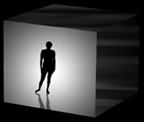
Six by Six
InterPlay: Loose Minds in a Box is a collaborative work that explores the basic concept of the "box". The box is a metaphor for the physical, social, political or psychological constraints that we and/or others place upon us. The box also represents a sense of place in the realm of the virtual as well as in our sub-conscience. InterPlay is a multi-faceted telematic event that consists of six simultaneous performances that occur in six states throughout North America. The performances incorporate theater, text, music, performance art, virtual reality, and motion capture and are concurrently captured, mixed, digitized, encoded and streamed onto the network.
Posted by jo at 08:42 AM | Comments (0)
April 19, 2005
Mogame + IPerG
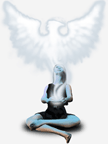
Body and Game Controller
"One of the central features in the future will no doubt be networked play. Most traditional games are inherently social, and a mobile gaming device with network access provides opportunities for social gaming virtually anywhere, anytime. The possibilities for new game mechanics, taking advantage of the full range of contextual information provided by pervasive systems, expand the research and design space further. This is one of the major research directions being explored by some ongoing projects in the Tampere GameLab. This is also where new approaches to Huizinga's bounded 'magic circle' of game playing are tried out and investigated." From The City Shaman Dances With Virtual Wolves–Researching Pervasive Mobile Gaming by Frans Mäyrä, Receiver #12.
Posted by jo at 11:24 AM | Comments (0)
Voicevertising
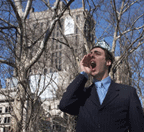
Capitalist Spin on the Town Crier
"Inspired by the recent bodyadvertising craze (the concept of auctioning advertising space on your body to the highest bidder) Floyd Hayes - a Brooklyn resident - came up with a new ad-dimension called Voicevertising. Floyd Hayes put his voice up for sale on eBay, promising to shout out a brand name as loud as possible every fifteen minutes for an entire week, no matter what location or situation. Quite fittingly, the highest bidder turned out to be 'HALLS Fruit and Breezers' - a company selling throat drops." [blogged on guerrilla-innovation]
Posted by jo at 11:07 AM | Comments (0)
Parking Public
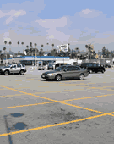
A Clash of Desires
With Parking Public, The Temporary Travel Office explores the largest openspaces around Hollywood Blvd, privately owned parking lots. The Travel Office is also interested in the relationships between the utopian spaces we all desire and the not-so-utopian spaces we end up inhabiting. This clash of desires and social realities is especially present in Hollywood, one of the centers of global utopian myth making. In order to bring these two worlds together, fantasy and reality, the Travel Office is distributing flyers on the windshields of parked cars soliciting answers to the question "what is your utopian destination?" By calling a phone number provided on the flyer, participants can leave a message describing their
dream locale, which is recorded on an audio blog. Because of the global network of influences on ideas of the utopian (those of us in the US often describe a tropical setting based on postcards and movies) as well as our material environment (the international distribution of goods and services), the survey is also open to people residing outside of Hollywood. The results of the survey are displayed on the web as they come in. A map of private parking lots and images from a walking tour are available on the site as well.
Posted by jo at 10:19 AM | Comments (0)
NANO
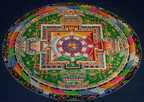
Immersed in Radical Shifts
Two UCLA professors--media and net artist Victoria Vesna and nanoscience pioneer James Gimzewski--are at the forefront of the intersection of art and science. Their groundbreaking project, NANO presents the world of nanoscience through a participatory aesthetic experience.
The project seeks to provide a greater understanding of how art, science, culture and technology influence each other. Modular, experiential spaces using embedded computing technologies engage all of the senses to provoke a broader understanding of nanoscience and its cultural ramifications. The various components of "nano" are designed to of scale and sensory modes that characterize nanoscience, which works on the scale of a billionth of a meter. Participants can feel what it is like to manipulate atoms one by one and experience nano-scale structures by engaging in art-making activities.
Posted by jo at 10:00 AM | Comments (0)
Intimate Transactions
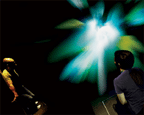
Embodied Experience For Two people in Two Locations
Keith Armstrong and the Transmute Collective invite you to book your own personal 1/2hr slot for the Australian Premiere of Intimate Transactions, a groundbreaking embodied, interactive experience for two people in two networked locations. Members of the public can experience Intimate Transactions for one week at QUT Creative Industries Precinct Brisbane and ACMI Melbourne commencing April 25 (details below).
The two participants will enter a space at each location that is equipped with a touch sensitive physical interface called a Bodyshelf, embedded with sensors that detect body movement and shifting of body weight. Before getting onto the Bodyshelf, each participant puts on a wearable device that passes gentle vibrations into their stomachs, enabling them to sense vibrations of different frequencies and intensities.
Each body movement influences an evolving world created from digital imagery and multi-channel sound, allowing the participants' bodies to become aware of the other's movements, despite the fact that they are geographically separated and cannot actually see or hear each other. Intimate Transactions is an ambitious new work from the renowned Australian Transmute Collective and collaborators, a group of internationally recognised media artists, performers, sound artists, programmers, scientists and furniture/interface designer.
The Melbourne/Brisbane event will be the Australian premiere of the work, following its international premiere at the New Territories International National Review of Live Art in Glasgow in February. ACMI Senior Curator Alessio Cavallaro said, "Intimate Transactions is an ingenious work that exemplifies both the fascinating developments in interactive moving image arts in Australia, and ACMI's leading role in introducing such innovative projects to broader audiences. Significantly, Intimate Transactions also demonstrates the importance
of ACMI's partnerships with artists and research centres to extend the creative application of new technologies and delivery systems."
The work has been developed in collaboration with the Australasian CRC for Interaction Design (ACID), QUT Creative Industries Research and Applications Centre (CIRAC), the RMIT Spatial Information Architecture Lab, and the Australian Centre for the Moving Image, Melbourne. Intimate Transactions will be presented simultaneously between the Queensland University of Technology Creative Industries Precinct, Brisbane, and ACMI, Melbourne. It is a featured work of the Australian Innovation Festival.
Dates: 25 April - 1 May 2005
Time: Mon 25th : 12pm=965.30pm,
Tues 26th =96 Sun 1st 10am=965.30pm
Admission Free - BUT Bookings Essential - Book your own personal 1/2hr slot at each venue.
Locations:
In Brisbane @ The block, Creative Industries Precinct, Cnr of Kelvin Grove Rd and Musk Ave, Kelvin Grove, Brisbane
FOR BOOKING ph. 07 3864 5495 e: kb.harding @ qut.edu.au
In Melbourne Screen Pit, Ground Floor, Australian Centre for the Moving Image at Federation Square, Flinders St, Melbourne
FOR BOOKING ph. 03 8663 2574
Posted by jo at 09:48 AM | Comments (0)
2home, james
![]()
Guarantee of the Performative
"Via text messaging English might evolve the markers of a locative case. Like Finnish with suffixes, e.g. houseto, clubto, house2, club2. But more likely with prefixes, 2house, 2gym. Very telling about the phenomenology of pointing, mapping and readiness to go.
There is an archaic locative case in Latin, which primarily was used in references to cities and small islands. But also, apparently, military command ("militiae"). When one thinks about it, the locative has much in common with the imperative, what Deleuze and Guattari, after Foucault, call "order-words," a kind of hierarchical sign. An order-word implies Austin's guarantee of the performative, sometimes covert, the "I make this so" of announcement, pronouncement, declarative, ontological presentness, magic. But more than that: the thing itself, which is often a scenario whose context bleeds far into the recesses, is so. (The classic example is marriage.)" From 2home, james, blogged by tobias van veen on MDCN.
Posted by jo at 09:35 AM | Comments (0)
April 18, 2005
Afterwords
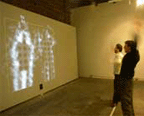
Experience Another's Memories
Afterwords--by Randy Moss and Michael Evan--examines personal identity, labels and the ephemera of the digital age. As people walk into the installation, they become a part of the display projected on the gallery wall in front of them. The display presents a stylized image of each person that follows their movements. A line of text floats above each person's head and follows them as they move through the space. People can touch the text to change it, run away from it, or stand still, allowing the text/image relationship to be distilled. Afterwords is part of the group show Help Wanted: Collaborations in Art at the Center on Contemporary Art in Seattle and runs ftill April 23, 2005. [blogged by Regine on near near future]
Posted by jo at 02:11 PM | Comments (0)
Music using Games

Game Engines to Performance Environments
"Following on from my research into controllers as instruments I have been looking at artists and programmers that have turned existing game engines info performance and composition environments. If you know of any more, please post a comment and I will post them here.
Vladimir Todorovic over at tadar.game music uses the Unreal engine for this purpose. He also provides the tools to download and do this yourself, as well as some mp3 releases.
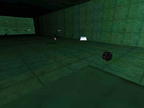
Andrew Garton in his audiovisual performance uses the unreal engine. Objects, which can be seen in this screen grab, have been assigned sounds which are set off when "nudged" by the player. Two to three levels are planned, each with their own set of sound objects that bounce from one end of the "performance space" to the other.
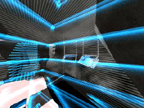
q3pd by delire and pix uses the Quake3 engine to synthesis sounds in Pure Data. Bot and player location, view angle, weapon state and local texture details are sent to PureData over a port connection. Any map can be used, but a map has been created specifically as a performance environment." [blogged by Chris from Pixelsumo]
Posted by jo at 12:31 PM | Comments (0)
Radical Software
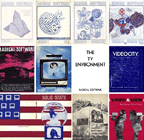
Video Art
"Radical Software was an important voice of the American video community in the early 70s; the only periodical devoted exclusively to independent video and video art at the time when those subjects were still being invented. Issues included contributions by Nam June Paik, Douglas Davis, Paul Ryan, Frank Gillette, Beryl Korot, Charles Bensinger, Ira Schneider, Ann Tyng, R. Buckminster Fuller, Gregory Bateson, Gene Youngblood, Parry Teasdale, Ant Farm, and many others.
Eleven issues of Radical Software were published from 1970 to 1974, first by the Raindance Corporation and then by the Raindance Foundation with Gordon and Breach Publishers. PDF files, opened with the popular application Adobe Acrobat Reader, can be downloaded and stored on a recipient's hard drive for later use. They can be enlarged, reduced, and zoomed in on. The recipient can not only read the text and view the graphics, but also view the original page layout."
Posted by jo at 08:26 AM | Comments (0)
AIM VI: Technological Pervasions

Light Attack by Daniel Sauter features at AIM VI in Pasadena
Art in Motion 6: The Sixth International Festival of Time-Based Media explores the ubiquity of surveillance in our daily lives and the numerous and complex forms of this technology in the new millennium. The exhibition includes Internet based projects; wireless technology; hardware design; video, digital video and animation; and interactive installations. In Light Attack, from media-artist Daniel Sauter, a virtual character explores the city of Los Angeles.
Featured artists also include Deborah Aschheim, Launa Bacon, Paul Chilkov, Dean Mermell, Dennis H. Miller, Henry Reichhold, Marcos Weskamp and Ellen Wetmore. The show is co-organized with the University of Southern California School of Fine Arts and the Armory Center for the Arts. The Armory Center for the Arts is at 145 North Raymond Avenue, Old Pasadena. The exhibition runs from February 27 through May 29, 2005.
Art in Motion was founded at the University of Southern California in 1999 in response to the high volume of new and innovative art that explored the countless developments in communications and media technologies and their social and cultural implications. AIM 6 is the third Art in Motion exhibition presented at the Armory.
Posted by at 12:33 AM | Comments (0)
April 16, 2005
prayingproject
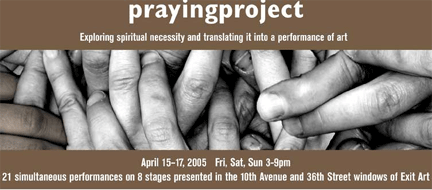
LIVE STREAMING - *praying project*
EXIT ART: April 15 - 17, Fri Sat Sun 3 - 9pm
Go to website then click on gray box below left that says: *Live Streaming prayingproject*
Posted by jo at 11:33 AM | Comments (0)
Global Pong
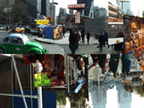
A Networked Babelogue Between Four Cities
Global Pong was a live dialogue on urbanism comparing local observations in New York City, Mexico City, Shanghai and Berlin, mediated through text fragments translated on-line into four languages. Texts were read live by a native speaker in its original language, cycled through four online translators projected as giant text banners, and then spoken again. Meanings shifted similar to a game of telephone ("teléfono descompuesto", "stille post"), and the four speakers added comments in their native language on each passing paragraph with keywords added into the translation cycle. Readers in this organic exchange of ideas included Vito Acconci, Andrés Oriard, Fu Xinian and Kai Vöckler.
Accompanying the texts were live video and sound components emanating from the four locations. Ralske created a visual interpretation/video collage from live webcam feeds. Composers in the four cities remotely contributed to a live ambient sound performance in which music files were passed along in an exquisite corpse style and "translated" similar to the textual work.
Posted by jo at 10:51 AM | Comments (0)
April 15, 2005
Emergences
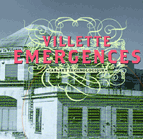
CALL FOR PROPOSALS
A festival dedicated to new artistic forms and new media, Emergences--organzed by Dedale.info--gathers French and international artists of the digital creation scene around a deeply transdisciplinary and original programming. For this third edition, we are looking for projects in all disciplines, especially, performances, circus, street theatre, puppetry, visual arts, architecture, game art, biotech art, artistic intervention in public space, networked performances (in the framework of collaborations with festivals in France and abroad). Main artistic themes:
Mobility, network and ubiquity | Intimacy, oddness and strangeness | Urbanity and nature | Art in urban space. A special attention will be carried to projects using the following technologies: * wireless and mobile technologies (cellphones, vocal servers, MMS, SMS, videophony, GPS, WiFi...), * sensors and remote interaction systems, * robotics and artificial intelligence, * biotechnologies.
Projects bringing in the audience or/and taking into account the venue will be welcomed as well.
These projects can, if necessary, be the object of an accompaniement in the realization within the framework of D-lab (production department of Dedale).
Deadline for submissions : 06/01/05
Information:
contact @ dedale.info | www.dedale.info
Posted by jo at 02:59 PM | Comments (0)
Urban Eyes
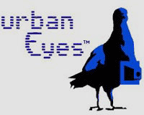
A Bird's Eyeview Experience to the Urban Public
Urban Eyes--by Martin Buschle, Marcus Kirsch, Jussi Ängeslev--is a service combining 2 natural networks, the CCTV and the pigeon population in a city to provide an alternative view on the city. Similar to shamanistic journey, a bond between human and an animal is created when one feeds the pigeon with Urban Eyes bird seed. When the bird flies about, the seed triggers the CCTV / webcam network in a city based on its proximity to the camera. The images are then sent to the person (his PDA) who fed the bird creating a story about the bird and the city.
Due to the purpose of the camera network, the view one perceives, is quite different from the market orientated, everyday media exposure. Ranging from traffic cameras on the lamp posts to gate cams to back yards and living rooms. The experience is essentially about being connected to the bird, the way it experiences the common living circles. Hence acquiring the data, the images and videos directly from the net would be utterly different experience, lacking the physical connection to one's environment and its inhabitants." [blogged by Martin Rieser on Mobile Audience]
Posted by jo at 09:40 AM | Comments (0)
ART BY TELEPHONE:
FROM STATIC TO MOBILE INTERFACES
"ABSTRACT: This article investigates artworks that use telephones as interfaces. Considering telephones as telepresence technologies, it focuses on the point of transition from the fixed to the mobile telephone, exploring how artistic practices change when one component is added: mobility. In addition, location awareness capabilities transform cell phones into more than voice devices. Consequences can be perceived in artistic experiences that bring the medium into public spaces, transforming them into ludic and collective interfaces, pointing to how mobile technologies can be used in the future. From a broader perspective, this study addresses how art mediated by technology deals with the connection between physical and digital spaces.
This article investigates how the artistic approach toward telephones changes when they become mobile. The transition occurs mainly because cell phones are no longer only voice devices. Mobility and location awareness transform them into social and ludic technologies, giving them the ability to merge physical and digital spaces and for a user to find one's relative position in the globe merely with a personal handset. Examples of artworks with fixed and mobile telephones help to clarify this transition.
Reviewing artworks with telephone handsets helps us to remember how the device has previously been used as an artistic interface and to imagine new approaches when this interface becomes mobile [2]." From Art by Telephone: From Static to Mobile Interfaces by Adriana de Souza e Silva
Posted by jo at 09:17 AM | Comments (0)
Movie-Drome
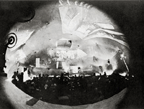
Network-Dependent Events
"Influenced by Buckminster Fuller’s spheres, (Stan) VanDerBeek had the idea for a spherical theater where people would lie down and experience movies all around them. Floating multi-images would replace straight one-dimensional film projection. From 1957 on, VanDerBeek produced film sequences for the Movie-Drome, which he started building in 1963. His intention went far beyond the building itself and moved into the surrounding biosphere, the cosmos, the brain and even extraterrestrial intelligence." [links to related texts]
BIOGRAPHY
Born in 1927—died in 1984. VanDerBeek studied art and architecture first at Cooper Union College in New York and then at Black Mountain College in North Carolina, where he met architect Buckminster Fuller, composer John Cage, and choreographer Merce Cunningham. VanDerBeek began his career in the 1950s making independent art film while learning animation techniques and working painting scenary and set designs for the American TV show, «Winky Dink and You.» His earliest films, made between 1955 and 1965 mostly consist of animated paintings and collages, combined in a form of «organic development.»
VanDerBeek's ironic compositions were created very much in the spirit of the surreal and dadaist collages on Max Ernst, but with a wild, rough informality more akin to the expressionism of the Beat Generation.
In the 1960s, VanDerBeek began working with the likes of Claes Oldenburg and Allan Kaprow, as well as representatives of modern dance, such as Merce Cunningham and Yvonne Rainer. Building his Movie Drome theater at Stony Point, New York, at just about the same time, he designed shows here using multiple projectors. These presentations contained a very great number of random image sequences and continuities, with the result that none of the performances were alike.
His desire for the utopian led him to work with Ken Knowlton in a co-operation at the Bell Telephone Company laboratories, where dozens of computer animated films and holographic experiments were created by the end of the 1960's. At the same time, He taught at many universities, researching new methods of representation, from the steam projections at the Guggenheim Museum to the interactive television transmissions of his «Violence Sonata» broadcast on several channels in 1970. [via Medien Kunst Netz]
Posted by jo at 07:13 AM | Comments (0)
April 14, 2005
Kings X Phone In

Musical Intervention
"During the day of Friday 5th August 1994 the telephone booth area behind the destination board at kings X British Rail station will be borrowed and used for a temporary cybercafe. It would be good to concentrate activity around 18:00 GMT, but play as you will." [see Heath Bunting's King's X Phone In]
"The calls "created a musical intervention that disrupted the daily routine of an urban transportation hub, as commuters circulating through the station chatted with strangers from around the world … public space was reconfigured aurally and socially."" From Heath Bunting's Kings Cross Phone-In and Lyotardian Disruptions by Jeff Lee
Posted by jo at 08:23 PM | Comments (0)
Trisha Brown
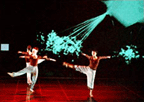
Dance With Electrons
"In this mysterious new piece, how long does the subject linger at the edge of the volume . . . . , the movement of the dancers generates digital signals that visual artists, working in real time, transform into cloudlike or striated shapes—imagine the strings of a parachute, or of marionettes, afloat in space—playing on a scrim at the front of the stage. Composer Curtis Bahn, who teaches at Rensselaer Polytechnic Institute in Troy, NY, and lectures on electronically extended instruments, dance, and performance technologies, uses the same data to create the accompanying sound, transforming raw material from acoustic instruments. When the dancers slow down, he reckons, the music will get busy." From Trisha Brown's Dance With Electrons Arrives at Lincoln Center by Elizabeth Zimmer, Village Voice, April 8th, 2005.
Posted by jo at 09:17 AM | Comments (0)
April 13, 2005
Organum Performance
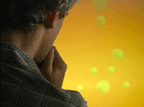
Voices as Game Controls
Organum is an interactive week of programs exploring the human voice through sound, image and technology. A week-long installation premieres Organum: The Game (2005), a video game by digital media artists Greg Niemeyer, Dan Perkel and Ryan Shaw, in which gamers navigate through the human voice box using their own voices as game controls. Also on view are glass etchings by Niemeyer and continuous screenings of Organum the short animated film (2003).
Organum: The Game is a collaborative video game in which three or more players sing into different microphones to control the three axes of movement (x, y, and z) on the game screen. Together, the players represent a grey sphere “character,” which they must navigate through an increasingly complicated path, hitting a series of targets as they travel through a luminous digital representation of the inside of the voice box.
New Langton Arts
Tuesday, 19 Apr 2005 to Saturday, 23 Apr 2005
12-6 pm, Admission Free
Reception: Saturday April 23, 6-8 pm
Organum culminates in a day of activities on Saturday April 23, from noon to midnight. An informal brown bag lunch with the artist/programmers is planned from noon to 3 pm, and the public is invited to an evening reception celebration from 6 to 8 pm. The finale, The Human Voice Explored, is a performance showcasing the vast potential of the human voice with Seth Augustus, Aurora Josephson, and Kid Beyond, at 8 pm. The space remains open until midnight for after-hours video game play. Organum is part of NetWork, Langton’s ongoing digital and net art exhibition program. [Related]
Posted by jo at 11:32 AM | Comments (0)
Mocean
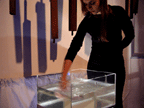
Sensory Relationships Between Natural Media
Mocean is a musical immersive environment that invites people to touch, stir and play with water in a tank. The movement of the water is translated into movement of air in the organ pipes suspended above the water. The sound of the pipes envelops the person, its movement echoing the waves and ripples in the tank.
The organ pipes are connected to blowers via a tubing structure. A video camera, placed below the tank, sends images to a computer, which analyzes the movement of the waves and sends commands to a microchip board, which turns the blowers on and off. The air from the blowers is routed to the organ pipes. The spatial arrangement of the pipes reflects the physical dimensions of the tank, thus it is possible to create the sensation of moving sound around by moving water in a particular direction. [blogged by Regine on near near future]
Posted by jo at 11:16 AM | Comments (0)
PUBLIC TRANSPHERE
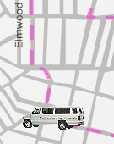
A Two-Way Mobile Communication Solution
Public Transphere is a free public transportation service for passengers from different parts of the city. Riders are encouraged to discuss their everyday realities, share opinions and exchange concerns about their communities. The event aims to bring residents of Buffalo together on an itinerant free speech platform, creating a nomadic, convivial environment in which they can converse about the communal experience of living in Buffalo.
Jesse Fabian imbues the vehicle with a small amount of self-awareness through sensation and self-localization. Through its many eyes, ears, its mechanical and electronic self-analysis, its data links, and its sensitivity to space, the vehicle assembles elements to form a picture of its whole self. The vehicle is reactive to its environment and its occupants. It participates in the journey as its passengers do.
Paul Visco will be manipulating live data collected by Jesse Fabian en route and enabling the public to explore these images, audio streams and GPS data feeds at http://www.public-transphere.info. At this site, the public will also be able to communicate live with the participants in the Public Transphere project, creating a unique two-way mobile communication solution during the event.
Public Transphere will be a two-day public event, taking place in a van touring three Buffalo neighborhoods: Allentown, the Buffalo Niagara Medical Campus and the Fruit Belt. The bus will be traveling among these three areas on Saturday, April 23 and Sunday, April 24 between the hours of 11:00AM and 2:00PM and from 3:00PM until 7:00PM.
Date: Sat. & Sun., April 23 and 24
Time: 11:00AM – 2:00PM, 3:00AM – 7:00PM
Place: Allentown, Buffalo Niagara Medical Campus, Fruit Belt
Cost: Free and Open to the Public
Contact: Arzu Ozkal Telhan at ao9 @ buffalo.edu and 716 - 400 6728
Public Transphere is the thesis project of Arzu Ozkal Telhan, an MFA candidate in the Art Department at University at Buffalo. Arzu Ozkal Telhan, Minoo Amini (UB, Center for Urban Studies), Jesse Fabian (UB, The Department of Media Study) and Paul Visco (UB, The Department of Media Study) are collaborating on this project.
Posted by jo at 10:45 AM | Comments (0)
April 12, 2005
Urban Tapestries
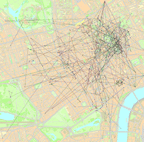
Experimental Ethnography, Technological Identities and Place
"Urban Tapestries provides a mobile location-based platform to connect people with the places they inhabit through their stories, experiences and observations. Currently based on an 802.11b mesh network in the heart of London, ordinary people author their stories of the city and embed them in the places that inspire them. Others who are logged into the system can read these stories, author their own and engage the largely invisible, multidimensional layers accumulating in the city. Our research asks if people use UT in meaningful and interesting ways. Drawing from theories of everyday life and urban space, we have developed experimental ethnography as a method for investigating the relationships between communication technologies, users and the socio-geographic territories around them. [blogged on pasta and vinegar]
Respondents are asked to play with an early Urban Tapestries prototype and this research explores what they do, their technological identities, their relationship to place and the meanings they generate. Urban Tapestries facilitates the negotiation of boundaries and we found that it does augment notions of connectivity – to place and to those within that place. However, our research revealed that some do not interpret this connectivity positively." From Urban Tapestries: Experimental Ethnography, Technological Identities and Place, an LSE Electronic Working Paper by Roger Silverstone and Zoetanya Sujon.
Posted by jo at 12:40 PM | Comments (0)
April 11, 2005
What's Eating Gilbert and Grape?
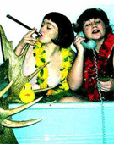
An Epic Voyage
"Courtship between two periods in history customarily leads to each sharing the other's things, like tastes for fashion, art and home decor. But, perhaps it is the impossibly bridged distance between flirting times and aesthetics that keeps history perpetually romancing itself. GilbertandGrape (hopefully their singing namesakes would enjoy being conflated with a Leonardo DiCaprio movie) are two New Europeans who describe their art practice as 'performance journalism.' Helen Pritchard (UK) and Anne-Marte Eidseth Rygh (Norway) have set out on a stubborn three-year journey called 'Lone Ranging Romance,' during which they will travel by Volvo through their homelands, with an iconic 20-kilo moose head, conducting interviews around the subject of nostalgia with the ‘heroes’ they meet along their way.
These found respondents will be subsequently mythologized into the epic voyage, and the interviews will be posted to GilbertandGrape’s blog every second Thursday of the month. 'Lone Ranging Romance' will conclude when the aforementioned moose head, 'The Lone Ranger,' reaches Nordkapp, Norway, 'where the midnight sun never sets.' This will occur in 2008, timed with the UK and Norway each hosting European Capitals of Culture, and thus becoming sites for historic and arbitrary convergence." - Kevin McGarry, Net Art News, Rhizome. Related [1] [2] [3]
Posted by jo at 09:20 AM | Comments (0)
Virtual Narrations

New Narration as a Mental Potentiality
"...Despite all of the intervening caesuras and interruptions, narration as a cultural practice seems to have experienced a virtual Renaissance at the end of the twentieth century.[2] Strikingly, this can be felt not only in literature and film, but with particular intensity in the electronic media. The Internet as a new mode of communication has achieved the status of a mass medium and now requires adequate ways of communicating content. But even the well-established medium of video is once again drawing on narrative strategies and establishing a form of storytelling that raises a variety of questions: Do these narrative practices really constitute a Renaissance of storytelling, i.e. do they represent the hope that, after the collapse of the great utopias in the seventies, a new form can be found with which to render narratives viable once again?..." from Virtual Narrations: From the Crisis of Storytelling to New Narration as a Mental Potentiality by Söke Dinkla, Medien Kunst Netz.
Posted by jo at 07:28 AM | Comments (0)
April 08, 2005
man in [ e]space.mov

Cine[mato]graphy and Choreography
The performance man in [ e]space.mov--by Wolf Ka--questions the representation of the body by declining the relationship between electronic space and man by merging two forms of writing the movement: the cine[mato]graphy and choreography.
The performance bases on techniques that marked the beginning of the cinema and which has introduced a new reading of the moving body: the reduction and abstraction of the human body and the decomposition of its movement in 24 images/second is in this creation assembled and recomposed in 3D space. This process, undertaken in particular by Marey and Muybridge is renewed here with the introduction of electronic and digital technologies.
As the title already suggests the performance directly refers to the experimental German cinema and dance of the 20th examining the notion of bodyspace according to the machine and its aesthetics. From Etienne Jules Marey cinematic work to the experimental work of artist such as Oskar Schlemmer and Oskar Fischinger they followed a systematic and radical way proposing a perspective of the body on stage as an abstract and symbolic representation as opposed to the psychological and expressive approaches. According to their choreographic and cinematic work, Man in e.space.mov pursuit these researches while confronting it to digital media, in between choreography, cinematography and scenography _ in between dance, music and architecture.
Having the same starting point the performance Man in e.space.mov is based on the complete reduction of space and body, a complete black space where the dancer is reduced to lines constituted through a light costume outlining the body articulation. A camera films the invisible moving dancer on stage, the lines in time, while capturing only 2 frames per seconds. These captured images are placed inside a 3d space which is projected in the back of the stage. Each sequence new images are added, thus building up slowly a strip-man like animation out of the captured image. Once reached 24 frames/s the formed strip-man juxtapose to the performer on stage and thus construct a second ‘virtual’ dancer. Through this juxtaposition a dance, a movement, is constructed in between the dancer and its own images. On one hand the cinematic construct is directly derived from the dancer’s movements but the temporal programming also constitutes an unpredictable parameter giving autonomy to the self residual image. The result is not only a superposition of the image to the body but also from the subject to the object.
Posted by jo at 04:12 PM | Comments (0)
Neural.it

Networked Art Staple
The new printed English edition of Neural is out. Inside this issue: Ubermorgen (interview) . Jonah Brucker Cohen (interview) . Infection as Communication . Videogame Art . news (Wimp, mirrorSpace, Fenlandia, Panos, txtkit) . reviews (Media Art Net, Future Cinema, The Cinema Effect, Frags, net.art generator, Understanding Media Theory, First Person, Windows and MIrrors) . Staalplaat Soundsystem (interview) . Cronica (interview) . The Sequencer Paradigm . news: (Shadowplay Reanimated, Spinalcat, Sonic Fabric, Let Them Sing For You, Tectonic Plates) . reviews: (P. Glass S. Reich, DJ Spooky, Delaware, Bianco-Valente, D.Cope, Pure Dekam, Dextro - A/Turux-B) . reviews cd: (Duran Duran Duran, The Loop Orchestra, Kinetix, Richard H Kirk, Robot Friend, Rennie Pilgrem, Radboud Mens, A Guy Called Gerald, Venetian Snares...) . Molleindustria interview . Lawrence Lessig interview and more...online NEURAL.
Posted by jo at 03:40 PM | Comments (0)
Mobile Digital Commons Network Symposium
![]()
Sampling the Spectrum: The Politics, Practices and Poetics of Mobile Technologies
Hosted by the Mobile Digital Commons Network (MDCN), this symposium--May 5th-8th, 2005, Montréal, Canada--examines the impact of mobile culture and the evolving idea of a wireless commons. Over the course of four days, we will investigate how wireless technologies enrich and modify public life in Canada, challenge our notions of space and place, and shape our day-to-day experiences.
Leading researchers, scholars and artists from around the world have been invited to present their cutting edge work in these fields and contribute to an ongoing discussion on these subjects. This event will also serve as a public unveiling of the projects that constitute the launch of the MDCN.
The MDCN connects those members of the academy, the arts and industry whose work revolves around mobile, wireless, and digital technologies in Canada. Funded by Canadian Heritage, our goals are threefold: to facilitate interdisciplinary research; to foster cultural production and public participation; and to develop forward-thinking policy on wireless technologies.
Posted by jo at 02:26 PM | Comments (0)
MAY YOU LIVE IN INTERESTING TIMES

OPEN TO ALL ARTISTS WORLDWIDE
MAY YOU LIVE IN INTERESTING TIMES is Cardiff’s inaugural festival of creative technology - a three-day programme of events being held across the capital. The festival is being developed between bloc and Chapter. The residency programme for the festival is supported and managed by Cywaith Cymru/Artworks Wales), the national organisation for public art in Wales. The festival residencies are supported through the National Lottery celebration of Cardiff 2005.
ARTIST-IN-RESIDENCY OPPORTUNITIES: The BBC Wales New Media’s mobile studio is a touring bus which has onboard a broadcast production studio with wireless broadband internet access, a network of six PCs, a large TV/plasma screen, a Sony HDV broadcast TV camera, digital cameras and scanners. Travelling with the bus is a driver, a producer, a community researcher, and a Lifelong Learning advisor. All the staff are bilingual (Welsh/English). The bus is a partnership between BBC Wales, The Welsh Language Board and University of Wales, Bangor.
Through this residency the artist/s will address the festival’s theme of investigating the ‘places’ where digital technologies become grounded in a geographical and social context. Through the project the artist/s will realise a work that encourages and extends the public’s initial or early contact with digital technology. The project will focus on community participation and exchange and will need to be structured to manage both Welsh and English language content.
It is anticipated that the artist will fully utilise the technology available in the mobile studio, the expertise of the crew, and the studio’s portability. It is anticipated that the work will have a strong visual/audio presence in Cardiff during the festival. The work will also have dual visibility at Oriel Mostyn gallery, Llandudno, North Wales during the three-days of the Cardiff-based festival (www.mostyn.org).
During the residency the artist will be based in North Wales at the BBC’s mobile studio. The bus has a schedule which takes it throughout North Wales and the appointed artist/s will work with the bus team to schedule stops.
The artist will also have access to support from the BBC’s main office in Cardiff. BBC Wales New Media is the cross-media, online, interactive and mobile department within BBC Wales. For further information on the host visit http://www.bbc.co.uk/wales.
Festival Theme: Artists are increasingly engaged with or inspired by digital technology - exploring consumer and communication technologies such as the worldwide web, mobile networks, file sharing, and computer gaming. Because digital technology is a participatory medium with global reach, artists tend to explore digital technology in the context of public and shared spheres. Often digital art is situated somewhere between public art - albeit in a dematerialised form - and street culture where the technology itself is used as a ‘site’ for the production and presentation of art works. Although digital technology is often claimed to go beyond physical limitations, engagement with technology is always embedded in, or grounded in, real spaces and places whether this is explored from a user or network perspective.
The Residencies: The residencies form part of the festival’s core programme where artists are being invited to investigate the ‘places’ where digital technologies become grounded in a geographical and social context. It is anticipated that the work from the residencies will have a strong presence in Cardiff during the festival period - 28th to 30th October 2005. All commissioned works shown at the festival will negotiate with the specifics of the location at various ‘sites’ in order to bring about activity and exchange beyond the gallery.
The residencies are open to an artist or group of artists and cover a period spent with the residency host between June and November this year (the timing of the residencies is negotiable although the work must be made evident during the festival period).
Fee: There is a fee of £3,600 (30 days), material budget of £750, and outreach travel of £250.
Deadline: Posted applications should be received by FRIDAY 29th APRIL 2005. Shortlisted artists will be notified on 6th May, interviews are to be held in Welshpool, Mid-Wales on the 1st June.
Selection Panel: Hannah Firth (Curator, Chapter/ Festival Director), Emma Posey (Director, Bloc/Festival Director), Iain Tweedale (Editor, BBC Wales New Media), and Walt Warrilow (Project Manager, Cywaith Cymru/Artworks Wales).
If you have any questions or would like to have an informal discussion about this residency please email Walt Warrilow: walt @ cywaithcymru.org.
Applicants should post their CV, a proposal of no more than 1 side of A4 stating ref: May you participate in a digital world, and supporting visual material in slide or CD format to:
May you participate in a digital world
Cywaith Cymru . Artworks Wales
Crichton House
11-12 Mount Stuart Square
Cardiff
CF10 5EE
UK
T: +44 (0)29 2048 9543
F: +44 (0)29 2046 5458
www.cywaithcymru.org
e: walt @ cywaithcymru.org
Posted by jo at 01:22 PM | Comments (0)
The places of locative media
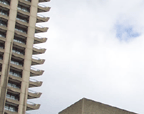
Case, not Place
"Karlis Kalnins said that "Locative is a case, not a place" - which sounds catchy but confuses me.
If the locative case "indicates a final location of action or a time of the action" then how is 'locative' not a place? From what I gather, Karlis was trying to introduce the concept of time, but I've never seen a definition of location that excludes time. Location and its most common synonym, situation, are always already space-time coordinates. [blogged by Anne Galloway on purse lips square jaw]
To me, what makes the locative case most interesting is how it expresses the cessation of movement, or the end of mobility. So side-stepping the disciplinary society vs. society of control debate, I'm intrigued by the tension that exists when mobile technologies are used to stabilise or freeze relations.
[Note to self: find out if anyone has discussed locative media representations in terms of diagrams, indexes, signs, icons and/or symbols. See A Thousand Plateaus p. 142 for definitions]
And I'm not sure exactly how this is related, but I keep thinking about this NY Times story about people taking pictures of the Pope:
"In the past, pilgrims would take away with them a relic, like a piece of cloth on the saint's body. Here there's been the transposition to a level of unreality. They're bringing home a digital relic ... With the cameras of the world focused on it, St. Peter's has become the sancta sanctorum of the digital world. While they're waiting in line they could be chanting or praying but instead they're taking pictures because they're caught in a parallel event.""
Posted by jo at 09:44 AM | Comments (0)
Storytronics
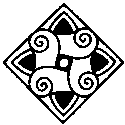
Dance and Deep Hypertext
Some Hypertext researchers pointed out the relationship between Hypertext and Dance, these years. Australian Hypertext researcher, Katherine Palps, invented the concept, Storytronics. This concept means that Hypertext and structure of myth. Like semiology by Vladimir Propp, Palps constructed the simple structure of myth and accommodated that to universe of Hypertext. With her experience of teaching in her class at Melbourne University, she found student who learn dance or architect can understand this concept easily because of dancer's three-dimensional cognition. Palps pointed out that dancers are easy to understand multi-dimensional Hypertext.
(Palps invented the concept "Ping Body" for Australian media performance artist STELARC. This concept is known as the title of his work in 1996. Her husband Andrew Pam is working as a chief programmer of Project Xanadu, the original Hypertext project by Ted Nelson.) Some important suggestions are came from engineers. A hypertext research group works with a dance researcher Janet Lansdale. (Miles-Board, Timothy and Deveril, and Hall, Wendy and Lansdale, Janet (2003) Decentering the Dancing Text: From Dance Intertext to Hypertext.)--by Yukihiko YOSHIDA
Posted by jo at 09:26 AM | Comments (0)
Pervasive Connections
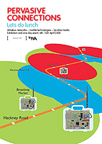
Lets Do Lunch
PERVASIVE CONNECTIONS/LETS DO LUNCH A one day event and exhibition focusing on opportunities for artists and local communities to work with new social technologies.
TAKE2030 takes its richair wireless lunchboxes out to lunch in Hackney and brings the conversations back to Space. Let's Do Lunch tracks Hackney's public access wireless connection points along bus route 26. Lunch dates will be set up with community members to exchange practical skills and visions for a wireless Hackney. The exhibition at SPACE will include a map of Hackney's wireless outposts along bus route 26, documentation of 7 lunch dates and auto transmitting wireless lunch boxes. Pump the signals, realise a wireless Hackney.
Pervasive Connections/Lets Do Lunch
Wireless Networks - Mobile Technologies – Locative Media Event
Saturday 16th April 10.30 – 5pm
Exhibition 6th – 16th April (Weds – Sat 1 TO 6pm)
SPACE, The Triangle, 129–131 Mare Street, London E8 3RH
£5 (includes lunch) booking required
Talks:
Introduction to Wifi - Saul Albert from Wireless London
Artist talk by TAKE 2030 linking to the exhibition Lets Do Lunch.
Workshops:
Network self provision– James Stevens Making flowers with palm top devices – Peter Chauncy Film for mobile phones – Melissa Bliss and Jes Benstock Public authoring and sharing local knowledge – Giles Lane
Panel discussion:
Featuring artists, activists and media practitioners, including James Stevens, Peter Chauncy, Graham Harwood, Matsuko Yokokoji, Rokeby, TAKE 2030, Indri Tulusun. Chaired by Pete Gomes – Wireless London
Let’s Do Lunch - 6 April – 16 April 2005. (Wed – Sat, 1-6pm)
Pervasive Connections/Lets Do Lunch is organised by Space and inIVA as part of Discover Hackney.
Booking To book a place on the one day event ‘Pervasive Connections’, please contact SPACE Media Arts on 020 8525 4344 or spacemedia@spacestudios.org.uk
Further information
http://www.spacemedia.org.uk
http://www.spacestudios.org.uk
http://www.iniva.org /
Directions
Bus: 26 & 48 from Liverpool Street, 106 & 254 from Bethnal Green, 55 from Old Street.
Tube: Bethnal Green.
Train: Hackney Central Silverlink.
Posted by jo at 09:19 AM | Comments (0)
April 07, 2005
cell.SPACE
![cellFREE[1].gif](http://www.turbulence.org/blog/images/cellFREE[1].gif)
freeSTYLE
Dana Karwas' cell.SPACE application allows users to make a short live music video using SMS as lyrics and camera phone pictures as graphics. Users can send text and picture messages from their mobile phone to the freeSTYLE and have their written text messages show up on the screen with a voice accompanying the text. Simultaneously a hip hop instrumental is creating and guiding the voice and graphics so the text becomes the lyrics and the pictures from the phones form the graphics.
The application has 21 different voices to choose from including male, female, creature, robot, and even human laughter. Instead of just being read back to the user, the voice is controlled by the beat of the music. [Video] The work will be at the Interactive Multimedia Culture Expo, on April 14th - 23rd, at the Chelsea Art Museum, in New York. [blogged by Regine on near near future]
Posted by jo at 05:43 PM | Comments (0)
Social Residue
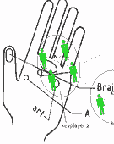
Online/Offline Hybridity
Social Residue--by Hyunjoo Oh and Noah Shibley--is a project that explores the relationship of online/offline hybridity to social connectivity, the mapping of complex social growth and the spread of ‘memes,’ that are brought and transmitted by artists and audiences during the show. By using a nontoxic invisible contamination simulation powder, Noah & Hyunjoo creates a gesture and organizational logic of mapping and cartographic spread vectors of social networks that develop during the show.
During the transmission process, there are many different kinds of social interaction involved consequentially or inconsequentially. It symbolizes that artists and audiences’ ‘presence’ and participation as performers whether they know or not. As a result of this performance, the visual map of spread vector will show the a multilayered spectrum of physical/virtual or online/offline networked systems through which social interaction is taking place in real time. [via Rhizome]
[d.t.t.e.d.q.u.a.d] a new media artist, technologist group that is co-founded by noah shibely / hyunjoo oh in 2002. Their works involve Virtual Reality, interactive storytelling, surveillance technology, improvisational network sounds, cartographic sciences, distributed social softwares, kinetics, database art and Networked sound synthesis. They are currently working on several virtual reality projects, such as Inside/Outside System II and Nodule Resonance and had joined the post-production team of the Chicago Millennium Park Fountain Project. Noah and Hyunjoo's work has been shown in Versionfest>04 (Chicago, IL), IMMEDIA (Ann Arbor, MI), OpenEnd Art, Polvo, Buddy, 1926 gallery and Chicago Tourist Center (Chicago, IL). Hyunjoo holds a B.F.A (2002) in Philosophy and Art Education from the SungKyunKwan University in Seoul, Korea and M.F.A (2005) in Art and Technology studies at the School of the Art Institute of Chicago. Noah received a BFA degree in Art & technology studies at the School of the Art Institute of Chicago and is currently in the graduate studies, Interactive Telecommunication Program (ITP) at the New York University.
Posted by jo at 04:49 PM | Comments (0)
April 06, 2005
Walking as Knowing as Making

A PERIPATETIC INVESTIGATION OF PLACE
Based in Urbana-Champaign at the University of Illinois, Walking as Knowing as Making is a multifaceted effort that seeks to nurture both a theoretical and applied approach to knowing and interpreting place as we experience and construct it through walking. Using the walk as a guiding metaphor the format of this symposium has been designed to encourage a sustained, rigorous, and layered yet experimental, diffuse, and meandering consideration of walking and its associated activities, systems, and values. Between February and May 2005 we will bring to campus a diverse group of scholars, activists, and pedestrians to present ideas, engage in conversation, generate questions, tell stories, and, of course, walk.
Supplementing and also weaving together this series of convergences will be a new interdisciplinary course about walking, an informal film series about place, a reading group, a series of informational and experimental walks and tours, production of a monthly sound collage for broadcast on local community radio stations, a museum exhibition, and a digital and print archive of all the events and activities.
Posted by jo at 08:24 AM | Comments (0)
PLAN Slides
![]()
Presentation Slides Now Available
The slides from the first PLAN event are now availaible. Pervasive and Locative Arts Network [PLAN] is a new international and interdisciplinary research network in pervasive media and locative media funded as part of the Engineering and Physical Sciences Research Council (EPSRC) Culture & Creativity programme.
The network brings together practitioners from a range of disciplines including artists, technology developers and ethnographers, with the aim of advancing interdisciplinary understanding and building consortia for future collaborative projects.
Posted by jo at 07:45 AM | Comments (0)
'Ere Be Dragons
![dragons2[1].jpg](http://www.turbulence.org/blog/images/dragons2[1].jpg)
Heartbeat-Based Game
'Ere Be Dragons, by Nottingham-based Active Ingredient, is the prototype of a game for PDAs that takes you into a virtual world created by your own heartbeat. As players travel through the landscape the physical and physiological changes in their body help to create a different world. The game responds to the location and physical activity of the players, measured by pedometers and heart-rate monitors.
At the start of the game you set your ideal heart rate range, go above or below this range and the world will begin to fade, only walking and maintaining your heart rate at a steady pace can keep the world alive. Throughout the game there is the sense of being chased. When you do well, the landscape blossoms, if you do badly then a mist appears and the landscape darkens. 'Ere Be Dragons aims to encourage people to exercise by walking and to learn more about their body. More in BBC Nottingham. [blogged by Regine on near near future]
Posted by jo at 07:04 AM | Comments (0)
April 05, 2005
Blowhard
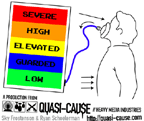
Investigating the Rhetoric of Fear Culture
Blowhard is a game, created by Ryan Schoelerman and Sky Frostenson, in which two players compete by breathing into a CPR mask, where a breath sensor translates cumulative respiration into the player's current level of anxiety, shown on a screen in the same color-coded system used by the Department of Homeland Security's Threat Advisory System.
Players must increase their anxiety gradually, moving up one stage at a time. Upon completion of a level the display provides feedback via audio-video USA fear culture propaganda from the 1950s to the present. The first player to reach the top, wins.
The respiration game controller masks are designed using a CPR resuscitation mask, TGS-822 organic vapor sensor and connect via ethernet cables to a game console. The console consists of programmed PIC micro-controllers, on-board LED display graphs, an audio sample processor, and speaker amplifier system. All hardware is housed inside a Playstation2 case.
The software screen display of BLOWHARD is designed using Max/MSP/Jitter.
The game is part of the Hybrid Vigor exhibition, at the Beall Center for Art + Technology on April 6 - 16, 2005.
Via Interactive Media Division.
Related: Homeland Insecurity Advisory System project.
[Blogged by Regine on near near future]
Posted by jo at 09:25 AM | Comments (0)
Audio Clouds

Body Talk
Building on previous work, researchers at the University of Glasgow have been developing Audio Clouds to control gadgets using movement and sound.
"The innovative aspect of this project is to explore a new paradigm for interacting with mobile computers, based 3D sound and gestures, to create interfaces that are powerful, usable and natural. The gesture modelling will be a novel combination of dynamic systems models and nonparametric statistical models. We will develop a wearable computer that uses 3D sound for output and head, hand and device gestures for input. This will allow us to investigate new presentation methods and interaction techniques to allow richer and more complex, tightly coupled interactions with mobile devices, opening up the possibilities for using mobile devices in a range of new ways." [via] [See 'Body Talk' Could Control Mobiles, BBC.]
Posted by jo at 08:59 AM | Comments (0)
April 04, 2005
MADRID ABIERTO
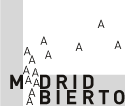
Call for Interventions
MADRID ABIERTO is a project framed within so-called Public Art i.e. interventions and performances derived from an artistic concept and developed preferably in a public and open context. Interacting with social and political processes, these works are aimed at the active or passive protagonists of such processes, i.e. all those people who, directly or indirectly, regularly or occasionally, live together in a specific physical, communicative, social and symbolic space, in this case, the City of Madrid. After the last two editions great success, the new project competition of artistic installations for Madrid Abierto 2006 is now underway.
PROJECT COMPETITION
1. The aim of this call is to select a minimum of ten projects for temporary or short-term artistic projects to take part in Madrid Abierto along with other guest projects.
2. The projects will take place coinciding with ARCO in February 2006 in Madrid, along the axis of Madrid's Paseo de la Castellana and Paseo del Prado boulevards'.
3. You may enter individual or group projects (for group projects you must name a representative). This call is open to artists of any nationality.
4. Each project must include:
* Curriculum Vitae of no more than 2000 characters and a photocopy of the DNI (Spanish National I.D. card) or an equivalent document of the author or authors' of the project.
* Description of the project of no more than 4000 characters.
* A maximum of six outlines and images of the project in jpg format with a resolution of 72 ppp.
* Description of the assembly system and technical requirements.
* Approximate and itemized budget, including details of the concepts which may be able to be self-financed.
* Maximum funding for each selected project is 12.000 euros, including all production, transport and assembly costs, the author or authors' fees and all applicable taxes.
5. Projects should be sent by e-mail to: abierto@madriabierto.com, before the 31st of May, 2005 (or by standard post to: Fundacion Altadis-Madrid Abierto, calle Barquillo, no. 7, 28004 Madrid, Spain).
6. The institutes promoting Madrid Abierto shall assign a commission to select the project, presided by the programme director. The commission will select a minimum of ten projects, evaluating the quality and viability of the proposals, as well as the total reversibility of the projects. As we are dealing with projects that will occupy public areas, it will be essential to obtain the corresponding authorisation from the municipal authorities for their installation.
If the selected projects make any use of third party images, the artists must provide the express authorisation of the owners of these images for their use in the project.
7. Madrid Abierto reserves the right of publication and reproduction of the selected projects for all case relating to the promotion of the programme, and shall incorporate all generated documentation into its documentary resources and public archives. The projects and works selected shall be the property of the authors and the promoting institutions shall have a preferential right to their possible purchase.
8. Participation in this competition entails full acceptance of the above rules and conditions.
For further information: http://www.madridabierto.com abierto @ madridabierto.com
MADRID ABIERTO is a project within what is generically known as Public Art. In the words of its organizer, Ramon Parramon, its objective is to “stimulate creative work in determined places that relate that which is typical of the place and the time in which the creativity takes place. It is to stimulate and generate work processes which take place over time, to boost immersion in the place itself and to interact in a section of public space that has a bearing on the social environment. Madrid Abierto is a programme based on this premise of influencing the public sphere and uses different public areas of the city of Madrid as its stage, proposing new formats and using existing channels or infrastructures which get the general public involved, both in the process and in the search for other people”.
Posted by jo at 09:25 AM | Comments (0)
TAXI MADRID
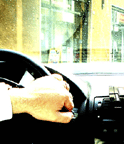
Another Taxi Installation
TAXI MADRID is a mobile public art intervention by artists Anne Lorenz & Rebekka Reich addressing issues of perception and the logic of memory. Equipped with installations, 12 taxis will operate in Madrid throughout the duration of Madrid Abierto, transporting their passengers into someone else's mind and memories of Madrid, those of an ex-patriot.
By interviewing former inhabitants of Madrid, who now live spread all over the world, artists Anne Lorenz and Rebekka Reich seek to find intriguing personal memories related to the city. From this material they devised sound-collages to become part of more complex installations, consisting of objects and other memorabilia, fitted into the taxis.
Regular taxi-users are caught off guard in the confined space of a car, abducted for a short amount of time from their everyday business. The artists seek to surprise and entertain the passenger by confronting him or her with an insight into the memory of a stranger, provoking a memory lapse. Due to the geographical distance of the interviewees an overlay of two pictures occurs: The out of date view of the ex-patriot merges with the current situation on site, and the meeting of the two lives on in the memory of the passenger.
To experience TAXI MADRID call Teletaxi: 91 371 21 31 / 902 501 130 and ask for a taxi from MADRID ABIERTO. Conditions are the same as usual.
Posted by jo at 09:15 AM | Comments (0)
Ondulation

Seeing Sounds + Hearing Images
Presented as a "temporal sculpture," Ondulation (2002) is a composition for water, sound and light created by Thomas McIntosh in collaboration with Emmanuel Madan and Mikko Hynnimen. They continued with Ondulation the exploration launched in finale, the final work in the Silophone project, pursuing their interest in synesthesia, where a visual sensation is experienced through its analogy with an auditory perception. The work is presented as both an installation and a performance piece. [via langlois]
"Among artistic precedents that share the concepts and forms of Ondulation are Mud Muse (1971) by Robert Rauschenberg and Mediations (towards a remake of Soundings) (1979/86) by Gary Hill. Mud Muse was the result of a collaborative effort between Rauschenberg and various engineers as part of the Art and Technology exhibition, which was organized by Maurice Tuchman and presented at the Los Angeles County Museum in May 1971." Read more >>
Posted by jo at 08:58 AM | Comments (0)
The Chinese Whispers
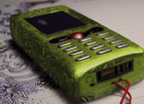
Connecting Through Misunderstanding
The Chinese Whispers (visklek in Swedish)--a project of The Interactive Institute in Sweden--is a game that you might have played as a child. Instead of sitting in a circle and whispering a word to someone sitting next to you, they have used answering machines, a web page and occasional actions in public spaces to create a game between different places and people.
By one single phone call the participants can play The Chinese Whispers. They can also create a new game by calling another phone number and adding a story of their own for others to play with. These chains of misunderstood and reinterpreted stories created by the participants are available at [visklek.se]. At the site anyone can follow the game, either by browsing through old messages or by listening to the game in real time. [via textually.org]
Posted by jo at 08:48 AM | Comments (0)
List of Music Tables
![reacTable3[1].gif](http://www.turbulence.org/blog/images/reacTable3[1].gif)
Tangible Musical Interfaces
"This is overview on tangible musical interfaces is focussing on table-top controllers, such as music tables and audio building blocks, mostly chosen for their relation to the reacTable* project. It also includes few additional projects, which we think are somewhat closer to the concept of tangible interfaces rather than simple musical controllers." [via near near future]
Posted by jo at 08:10 AM | Comments (0)
Telephony
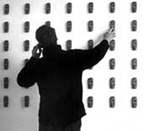
Nokiatunes
Telephony--by Thomson & Craighead--allows gallery visitors to dial into a wall based grid of 42 Siemens mobile telephones, which in turn begin to call each other and create a piece of 'music.' Each phone has been individually programmed with a different ringtone, which played en-masse, create various harmonic layers all of which are based in some way on the popular and prevalent, NokiaTune. The more people who dial into the work (whether inside or beyond the gallery walls) the more complex and layered the audio becomes. A piece of anodyne 'elevator' musac also plays into the space as a kind of background layer, and is also an improvisation on Nokiatune. [via neural.it]
Posted by jo at 08:01 AM | Comments (0)
April 03, 2005
Games and Education
Technology and Games at the AERA Conference
The American Educational Research Association (AERA) Conference will take place in Montréal from April 11-15. Three symposiums will be dealing directly with issues on Games and Education:
- Games and Learning: Theory, New Technology, and Assessment
- Video Games and Digital Literacies
- Advanced Technology for Learning in School, Games, and Informal Settings.
Professors and scholars such as Kurt Squire, Katie Salen, and James Paul Gee will be presenting. For the symposium online program, go to the AERA website..
Here's the abstract of Games and Learning:"The shift toward situating learning and assessment in real-life situations has prompted the investigation of the potential of games in education. By bringing together scholars and game developers from backgrounds as distinct as education, design, and communication, this symposium will promote an interdisciplinary discussion on how games and simulations might be used to improve learning and assessment. In this symposium, presenters address games in the context of three interrelated issues: the role of games within the educational movement to provide more relevant experiences for students, the ways games can be used to promote learning and to assess knowledge, and finally, the implications of understanding the social aspects of games on game design."
Posted by at 11:36 PM | Comments (0)
April 01, 2005
Power Pilgrims
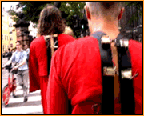
Electricity Keeps the World Together
The Amber pilgrims roam in and outside the exhibition space, ritually charging themselves with power. They rely on the generosity of others to share their 220V AC outlets. The pilgrims wear only the traditional Amber Robes. The robes are made of several pieces of fabric held together by recycled electro-magnets. The magnets are powered by a battery, fitted in a brazen container attached to the robe. Using the umbilical power cord the pilgrim recharges the battery from a normal wall socket. Without power the electro-magnets cease to function and the robe fall to the ground in pieces, leaving the pilgrim naked, ashamed and repentant.
The Power Pilgrims performance--by Unsworn--is a powerful illustration of how the meltage of man and machine always implies surrendering some control to larger technical structures. Wearing the Amber Robe produces a strong feeling of dependency. The experience makes the pilgrim intimately aware of the power outlet geography of her surroundings and the fragile nature of her identity. [via personaldebris]
Posted by jo at 03:41 PM | Comments (0)
wifi_art day
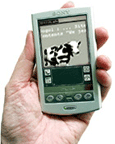
New Networks >> New Opportunities
"wifi_art day at Palais de Tokyo in Paris, France on April 5, 2005. Press conference with a presentation of Tokyo Ozone by Marc Sanchez senior curator of Palais de Tokyo with Rafi Haladjian CEO of Ozone and Valery Grancher new media artist, lecturer, curator and co-founder with Christophe Bruno of WiFi-ArT, and Frédéric Alstadt, Sébastien Fauvarque from Angström records.
Discover what is the WiFi and the opportunities brought by this network regarding art expressions, discover some artists projects who are using this new kind of network in openspace and public space. Ask some questions to the artists ! enter in Tokyo Ozone universe ! Enter in Ozone universe: a young startup who's producing pervasive objects which are bringing a new kind of communciation. Ozone is conceiving smart object for tomorrow."
Posted by jo at 03:21 PM | Comments (0)
Video-matic.nl

Mix Your Own
Video-matic.nl is an interactive video installation by Olga Mink. The projection is visible from both inside and outside the building. Interactivity is a crucial part of this installation, and is accomplished via the Internet or a touch-screen located in the main hall. The 'spectator' is invited to create a VJ-mix that is uploaded to the server in Sint Oedenrode. An automated video database ensures an ongoing supply of images, which makes this installation a dynamic piece of work evolving over time. There is a real synergy between image, light and the environment. [via Rhizome]
Olga Mink (Visual.Girlbot.Facility) is active as an artist in the Netherlands. She obtained her MFA at the Sandberg institute (Amsterdam). Next to art-projects she is a video-performance artist. Faster than the speed of light she takes the audience to unexplored areas, and shows them her abstract visual landscapes and rhythmic image-architecture.
The technical part of the installation is realized by Jilt van Moorst (NL). Jilt Van Moorst is a software-developer and graduated from the HKU (Art, Media & Technology). He also performs as Robotfunk and developed a VJ-tool called 'Flowmotion'. This sophisticated piece of software is used by VJ's allover the world.
Posted by jo at 08:27 AM | Comments (0)
UpStage
![]()
Walk-through: Wednesday 6 April
A platform for online performance, theatre and storytelling, UpStage is a web-based venue and tool for artists to compile different digital media for textual and audiovisual communication into a live performance, in real time, for online audiences. The walk-throughs, which usually last around 1-2 hours, give you hands-on experience of UpStage and how you can use it as a creative online tool. The next open walk-through in UpStage will be held on Wednesday 6 April, at 6pm New Zealand time (check here for your local time). There is a possibility of having a second session at a more civilized hour for people in Europe - if you're interested please email vhelen(at)creative-catalyst.com.
If you want to log in and play, email vhelen(at)creative-catalyst.com for a username and password, then go to: http://upstage.org.nz:8081 and log in. to join the audience, go to http://upstage.org.nz:8081/stages/presentation.
Posted by jo at 07:31 AM | Comments (0)
trans-mute

Filling in the Blanks
"Performance artist Daniela Sneppova’s text trans-mute has been published in the online journal ephemera as an interactive reading/translating experience. The following introduces the essay of her process oriented experiment - showing an understanding of the performative in general as an active communicative process...
"This textual representation moves between the inspiration – the triggers that led to the creation of the performance – and a description of what the audience participated in. The blacked out, missing text performs a number of functions. It refers to the acts of censorship by many Eastern European countries before the fall of Communism: Censors frequently obscured words or phrases in personal correspondence sent between nations, families and friends. [blogged by mo--ka on mind_ _the GAP*? ]
The missing text also seeks to reproduce the gaps and silences of translation. It is difficult to discern what is left out of a translation. We take for granted that what is missing from a translated text. However, I am interested in the cumulative effects of these ‘minor’ absences. Thus the invisibility of absence is something that is explored in the on-line project. The on-line project offers a different kind of text with which the user must actively engage; an environment of sound and images that responds to mouse movements and clicks. The blacked out text is meant to remind readers of the on-line dimension of this project. Readers will always make connections when reading any text; in this article that process is exaggerated, encouraging readers to ‘fill in the blanks.’"
This on-line version of trans-mute is an integration of a text translation and a digital translation of a performance that took place in Barcelona, 2002.
Posted by jo at 07:11 AM | Comments (0)
